Bhutan is a small landlocked country in the Himalayas, and is home to a wide variety of birds. Bhutan is home to over 700 species, making it one of the most diverse bird habitats in the world.
From large raptors like the Tibetan eagles and Himalayan vultures to smaller passerines like the white-bellied redstart and yellow-billed chough, Bhutan’s birds are varied and fascinating. This article will provide an overview of the major species of birds found in Bhutan, and discuss their behavior, habitat, and conservation efforts.
1. Black-Necked Crane
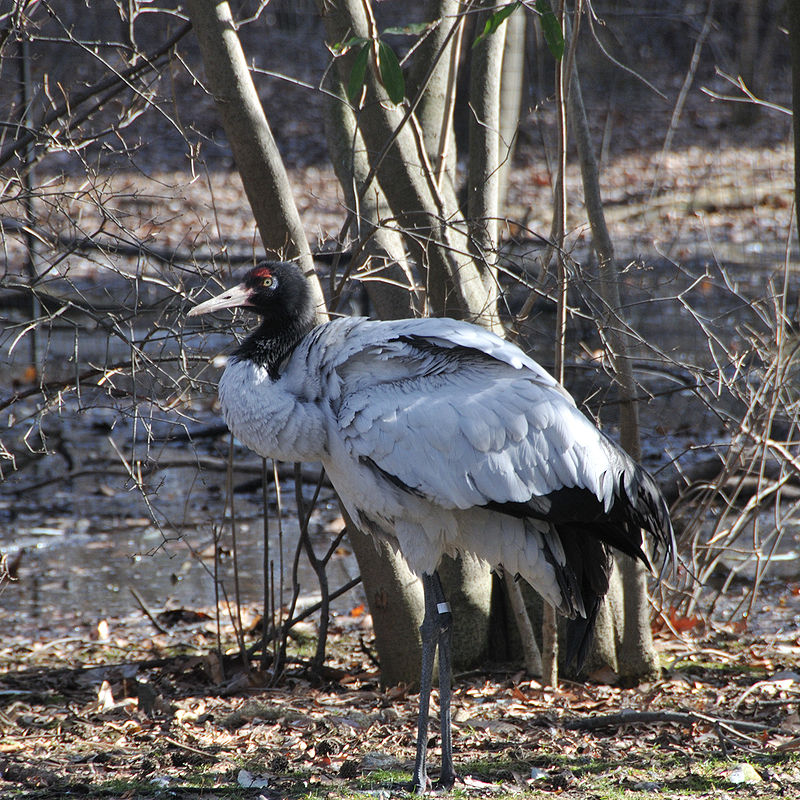
The Black-necked Crane is a majestic bird found in Asia. It has an impressive wingspan of 235cm and stands up to 139 cm tall.
Its feathers are whitish grey with beautiful black markings – head, neck and legs as well as the primaries and secondaries on its wings.
The white patch towards the back of its eye adds to their distinctiveness making them easily recognizable.
They can be seen flying gracefully over Tibet Plateau, India or Bhutan where they breed during summer months before migrating southwards for wintering grounds closer to sea level areas like Assam Valley in North East India.Scientific classification:
| Kingdom | Animalia |
| Phylum | Chordata |
| Class | Aves |
| Order | Gruiformes |
| Family | Gruidae |
| Genus | Grus |
| Species | G. nigricollis |
2. Satyr Tragopan
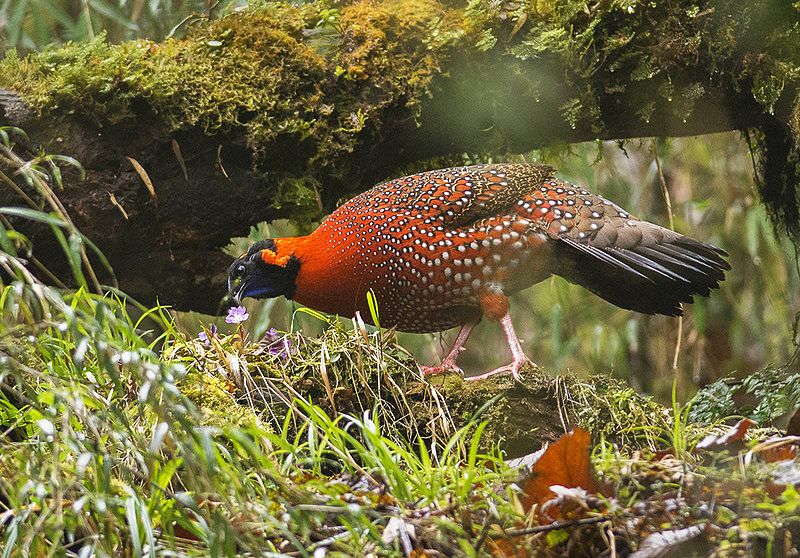
The Satyr tragopan is a majestic bird found in the Himalayan region of India, Tibet, Nepal and Bhutan.
It inhabits moist oak and rhododendron forests with dense undergrowth and bamboo clumps at altitudes ranging from 2400 to 4200 meters during summer months and 1800 meters during winter.
The male measures around 70 cm long. During mating season, males become even more striking as they display their beautiful crimson-colored horns atop their head while fanning out an impressive tail adorned with blue spots.
These birds are omnivorous but primarily feed on berries, fruits seeds plants shoots along with small insects like ants & beetles for added nutrition.
Its unique plumage makes it distinctive among other pheasants species making them popular targets for hunters who seek its feathers as trophies or decorative items .Scientific classification:
| Kingdom | Animalia |
| Phylum | Chordata |
| Class | Aves |
| Order | Galliformes |
| Family | Phasianidae |
| Genus | Tragopan |
| Species | T. satyra |
3. Ward’s Trogon
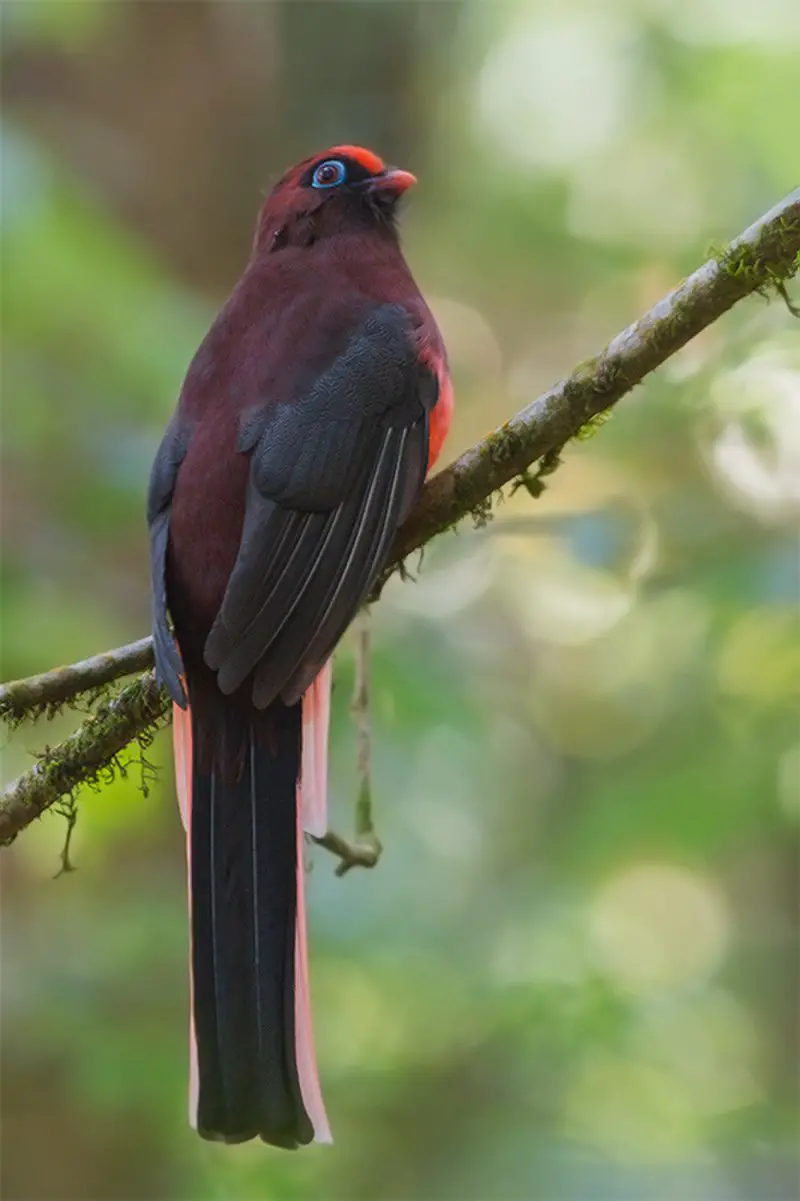
Ward’s trogon is a species of bird found in the northeastern parts of India, Bhutan, Tibet and Myanmar. It has a disjunct population in northern Vietnam but there have been no recent sightings.
This colorful bird inhabits temperate forests as well as subtropical or tropical moist lowland forests up to 10,000 ft above sea level.
Male Ward’s Trogons are most easily identified by their iridescent green upperparts with white underparts and reddish-orange wings; females look similar but lack the orange wing feathers.
They mainly feed on insects such as beetles and cicadas which they catch from branches while perched motionlessly for long periods of time.
Breeding season begins around March when males can be heard singing melodious calls during dawn or dusk hours.Scientific classification:
| Kingdom | Animalia |
| Phylum | Chordata |
| Class | Aves |
| Order | Trogoniformes |
| Family | Trogonidae |
| Genus | Harpactes |
| Species | H. wardi |
Also Featured In: Birds that Commonly Found in Andhra Pradesh,
4. Rufous-Necked Hornbill
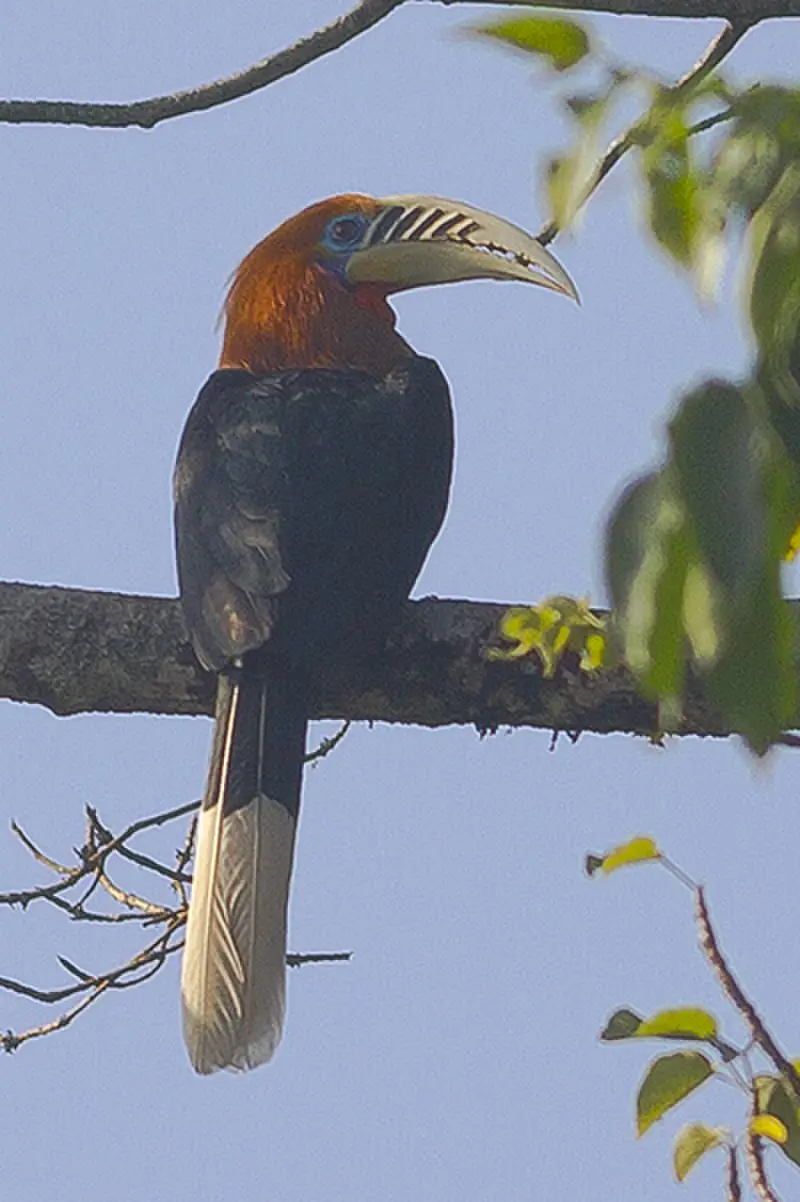
The Rufous-necked Hornbill is a beautiful and majestic bird found in Bhutan, northeastern India, especially Arunachal Pradesh.
It has been sadly declared locally extinct in Nepal as hunting accelerated its decline along with loss of habitat due to human interference.
This large Bucerotine hornbill measures approximately 117 cm long and there are less than 10,000 adults remaining in the wild today.
Its striking plumage consisting of black body feathers edged with white; yellow legs and bill; red throat patch on males (orange for females) make it a truly remarkable sight when seen up close.Scientific classification:
| Kingdom | Animalia |
| Phylum | Chordata |
| Class | Aves |
| Order | Bucerotiformes |
| Family | Bucerotidae |
| Genus | Aceros Gray, 1844 |
| Species | A. nipalensis |
5. Himalayan Monal
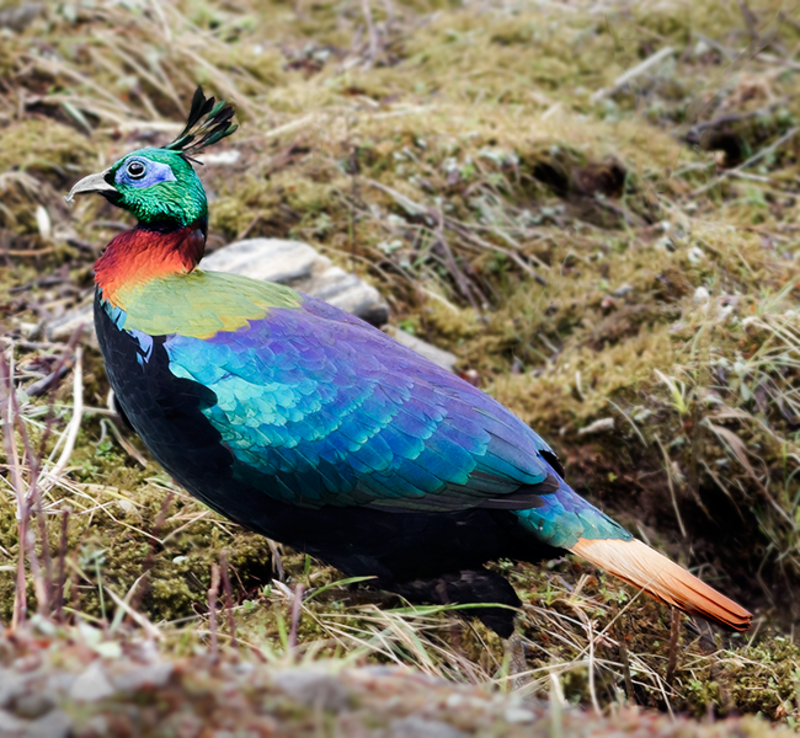
The Himalayan monal (Lophophorus impejanus) is a beautiful species of pheasant native to the forests and shrublands of the Himalayas. It can be found at elevations ranging from 2,100-4,500 meters.
This magnificent creature has been listed as Least Concern on IUCN’s Red List due to its wide distribution range and stable population size.
In Nepal it is known as Danphe or Danfe, which also happens to be their national bird.
Uttarakhand in India recognizes this species as their state bird too. The colorful feathers boast hues of green, blue and bronze that make them quite captivating to watch out for.Scientific classification:
| Kingdom | Animalia |
| Phylum | Chordata |
| Class | Aves |
| Order | Galliformes |
| Family | Phasianidae |
| Genus | Lophophorus |
| Species | L. impejanus |
6. Great Hornbill
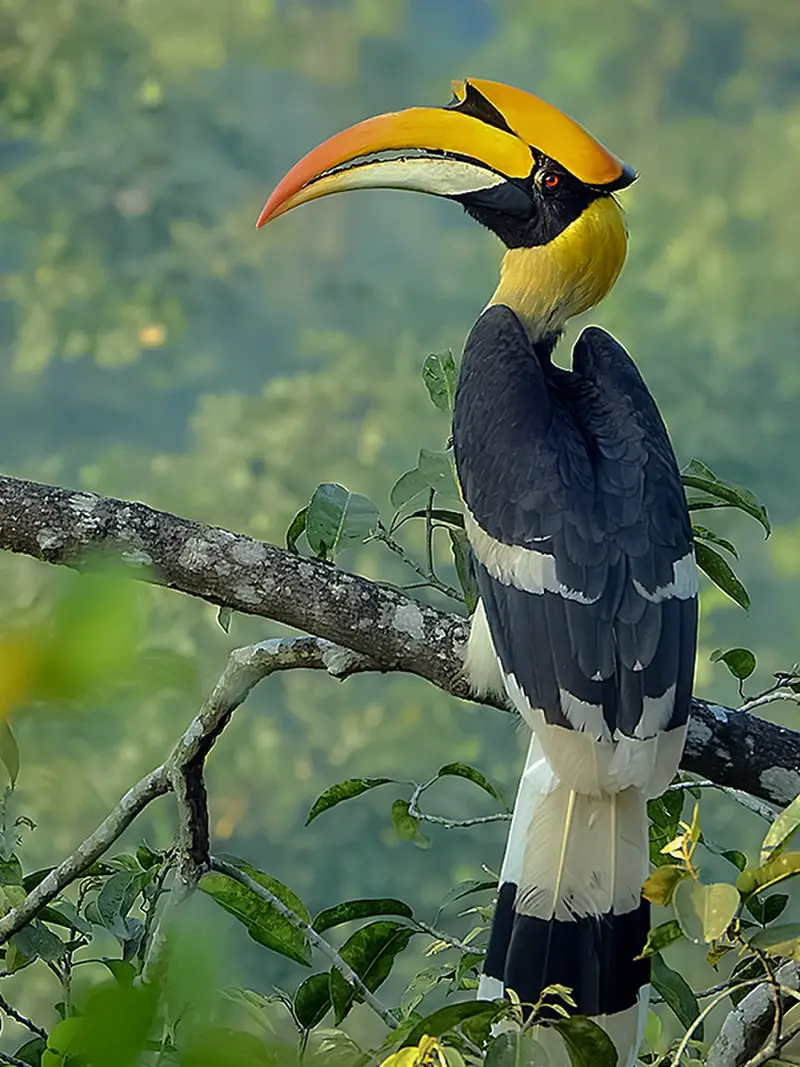
The Great hornbill is an impressive bird, belonging to the family of Hornbills. It can be found in India and Southeast Asia, mainly eating fruits but also preying on small mammals, reptiles and birds.
Its striking looks include a concave casque which sits atop its head as well as vibrant yellow-orange feathers covering much of its body.
Unfortunately it’s listed by IUCN Red List since 2018 due to habitat loss resulting from deforestation for agriculture and timber logging activities taking place across the world today.
Despite this sad news there are still conservation measures being taken such as education programs focusing on sustainable farming practices that will help protect this amazing species’ future.Scientific classification:
| Kingdom | Animalia |
| Phylum | Chordata |
| Class | Aves |
| Order | Bucerotiformes |
| Family | Bucerotidae |
| Genus | Buceros |
| Species | B. bicornis |
7. White-Bellied Heron
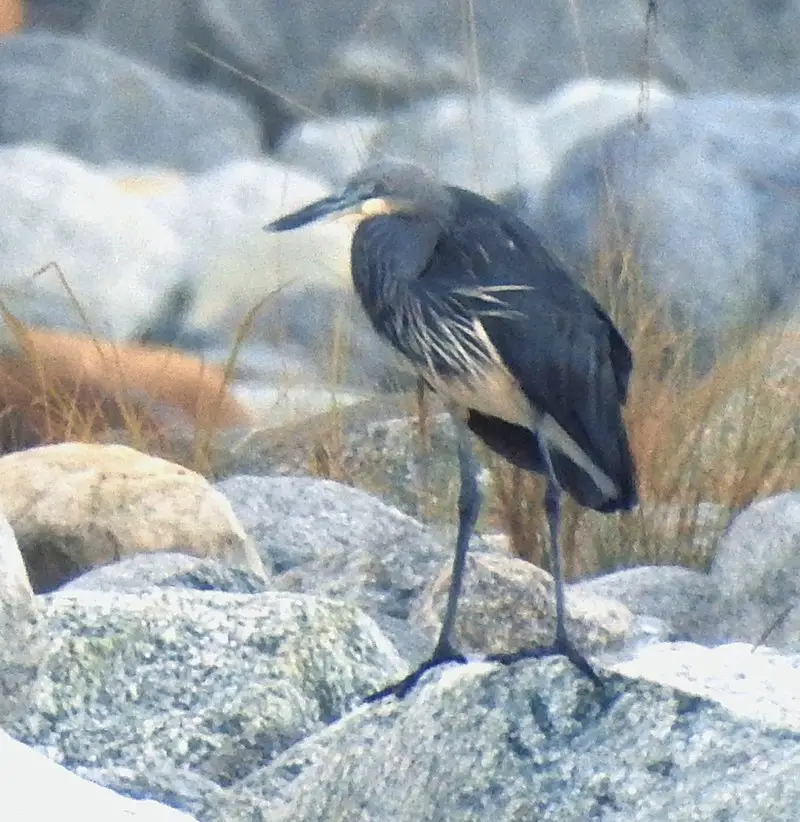
The white-bellied heron, also known as the imperial or great white-bellied heron, is a large species of bird native to eastern Himalayas and parts of northeast India.
It inhabits undisturbed rivers and wetlands in these areas and has long been an important part of the local ecosystem.
Unfortunately their numbers have dwindled over time due to human activities such as deforestation leading them being listed as critically endangered by IUCN Red List since 2007.
This majestic bird stands about up 1m tall with its body mainly covered in grey feathers while its head is topped off with a beautiful crown of black feathers that contrast against it’s white chest plumage – making it quite impressive sight when seen close up.
As they are so rare now, conservation efforts are essential if we want to protect this vibrant species from extinction for generations come.Scientific classification:
| Kingdom | Animalia |
| Phylum | Chordata |
| Class | Aves |
| Order | Pelecaniformes |
| Family | Ardeidae |
| Genus | Ardea |
| Species | A. insignis |
8. Beautiful Nuthatch
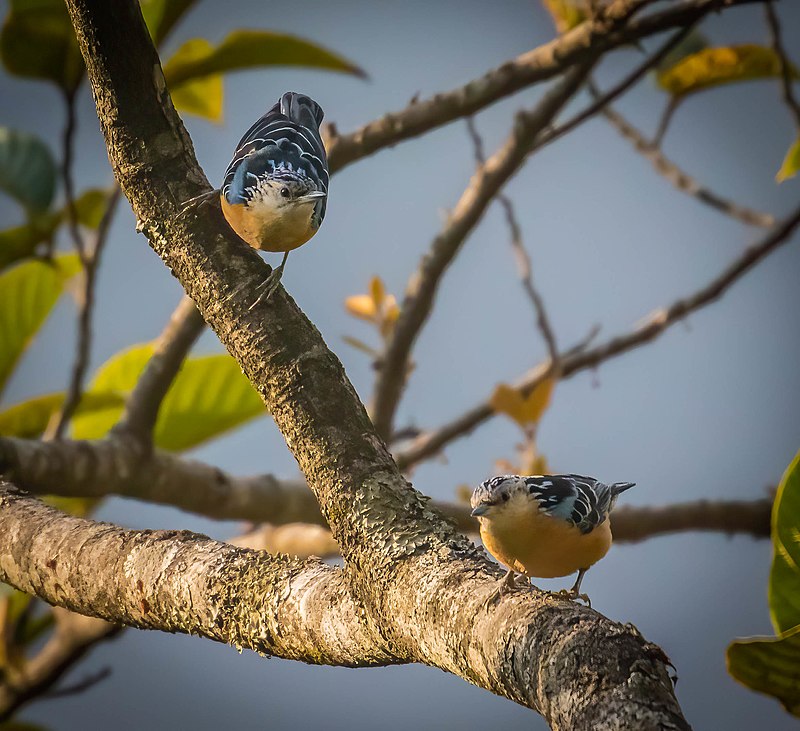
The Beautiful Nuthatch is a stunning bird from the Sittidae family. It is 16.5 cm long and has no sexual dimorphism, meaning males and females look alike.
Its vibrant plumage consists of black, azure blue and white wings with light blue streaks on its head.
The underparts are yellowish-brown with dark stripes down each side to complete this striking appearance.
This species can be found in East Asian countries such as India, China and Japan where it enjoys foraging for insects on tree trunks or hopping along branches like other nuthatches do.
They often make their homes in cavities inside trees which provide protection from predators while also giving them plenty of food sources nearby.
These birds have adapted well to urban landscapes too; they will even enter houses if there’s an open window.
All in all, the beautiful nuthatch provides us with a fascinating sight that we should continue to preserve by protecting its natural habitats around the world.Scientific classification:
| Kingdom | Animalia |
| Phylum | Chordata |
| Class | Aves |
| Order | Passeriformes |
| Family | Sittidae |
| Genus | Sitta |
| Species | S. formosa |
9. Yellow-Rumped Honeyguide
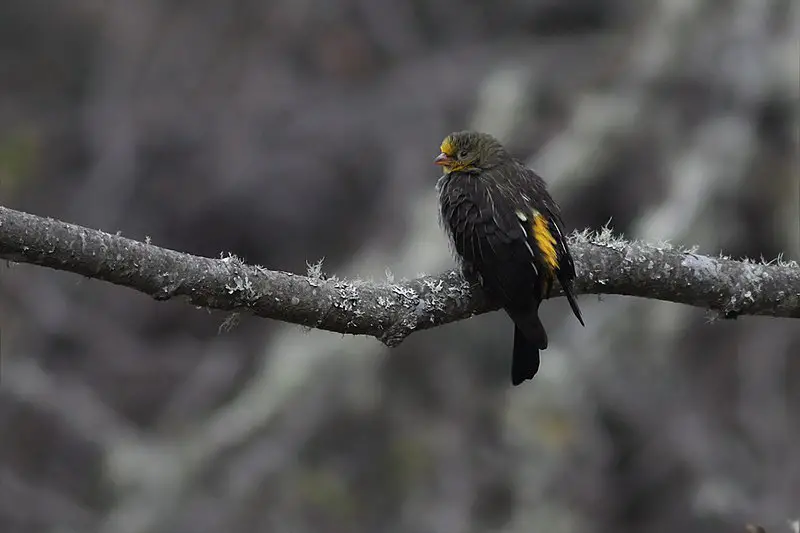
The Yellow-rumped Honeyguide is a small, sparrow-like bird with strong and zygodactyl feet. It inhabits montane forests of the Himalayas in Asia and feeds on wax from honeycombs.
Males are territorial and stay close to their honeycomb while females travel further distances for food. These birds have yellow rumps that distinguish them from other species of honeyguides.
They also possess pointed bills which they use to pry open bee nests for larvae or pupae as part of their diet.
During mating season males perform elaborate courtship displays involving song, feather fluffing, bill pointing, tail fanning and bowing movements to attract potential mates.
The female will then lay up two eggs in an unlined nest usually made out of twigs or grasses near a colony entrance where she incubates them until hatching occurs about 12 days laterScientific classification:
| Kingdom | Animalia |
| Phylum | Chordata |
| Class | Aves |
| Order | Piciformes |
| Family | Indicatoridae |
| Genus | Indicator |
| Species | I. xanthonotus |
10. Blyth’s Tragopan
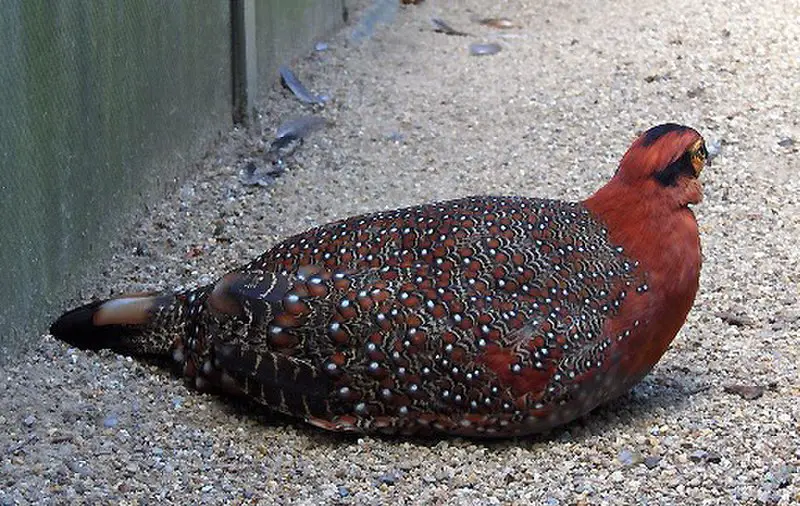
Blyth’s tragopan is a pheasant species that is currently classified as vulnerable. It was named after Edward Blyth, an English zoologist and Curator of the Museum of the Asiatic Society of Bengal in 1810–1873.
This colorful bird has black and white feathers on its wings with grey bellies. The population for this species is small and believed to be decreasing rapidly due to human activity such as habitat destruction and hunting for food or sport purposes.
They can be found in various areas including Bhutan through India up into China, across Southeast Asia towards Thailand, Vietnam and Cambodia.
To conserve these birds it’s essential we protect their habitats by limiting activities like logging which are destroying natural environments where they live while also increasing public awareness about them so people will take more action to help save them from extinction.Scientific classification:
| Kingdom | Animalia |
| Phylum | Chordata |
| Class | Aves |
| Order | Galliformes |
| Family | Phasianidae |
| Genus | Tragopan |
| Species | T. blythii |
11. Hodgson’s Redstart
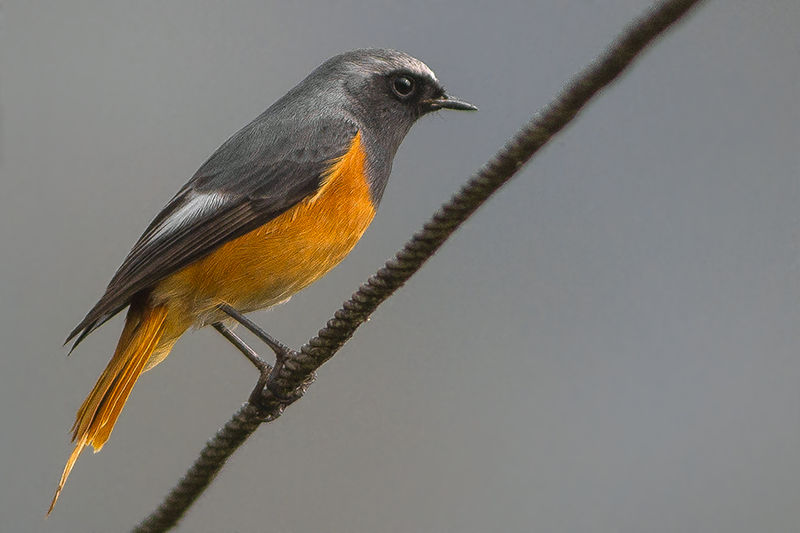
Hodgson’s redstart is a species of bird belonging to the Muscicapidae family. It can be found in Bhutan, China, India, Myanmar and Nepal.
Its favoured habitat is temperate forests and it also visits Himalayan regions during wintertime.
This beautiful little creature has grey upperparts with an orange-rufous tail that makes them stand out from other birds.
They have dark wings with white patches on the flight feathers as well as a chestnut breast and throat which contrast against its white belly patching together for quite a unique look.
Hodgson’s redstarts are known to inhabit alpine meadows, grasslands or coniferous forests at higher altitudes making them wonderful sights when you come across one while venturing through these habitats during winters.Scientific classification:
| Kingdom | Animalia |
| Phylum | Chordata |
| Class | Aves |
| Order | Passeriformes |
| Family | Muscicapidae |
| Genus | Phoenicurus |
| Species | P. hodgsoni |
12. Pallas’s Fish Eagle
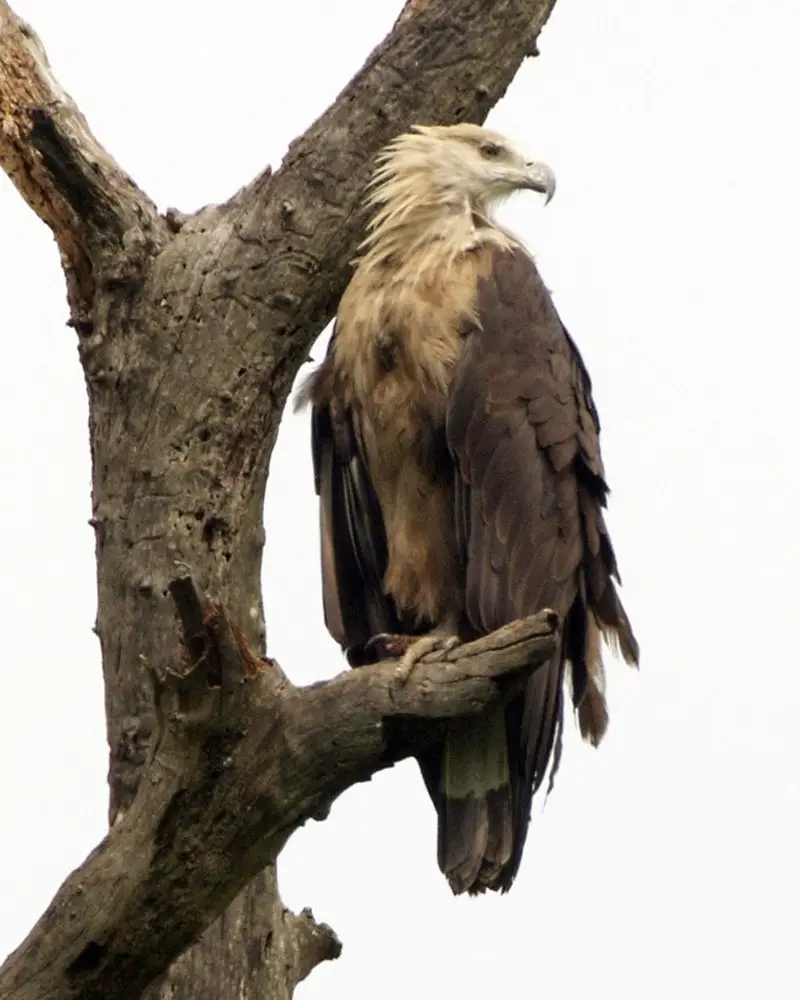
Pallas’s fish eagle is a majestic bird that breeds in east Palearctic. It has a brownish colour and is classified as Endangered on the IUCN Red List due to its decreasing population.
It migrates partially, with Central Asian birds flying south during winter months for food.
This species feeds mainly on fish which it catches near riverbanks or coasts using its sharp talons and powerful wingspan of over six feet.
Although they are difficult to spot due to their elusive nature, Pallas’s Fish Eagle remains an integral part of many ecosystems across Asia where its presence helps keep other populations healthy by controlling the number of fishes available for consumption.Scientific classification:
| Kingdom | Animalia |
| Phylum | Chordata |
| Class | Aves |
| Order | Accipitriformes |
| Family | Accipitridae |
| Genus | Haliaeetus |
| Species | H. leucoryphus |
13. Blue-Bearded Bee-Eater
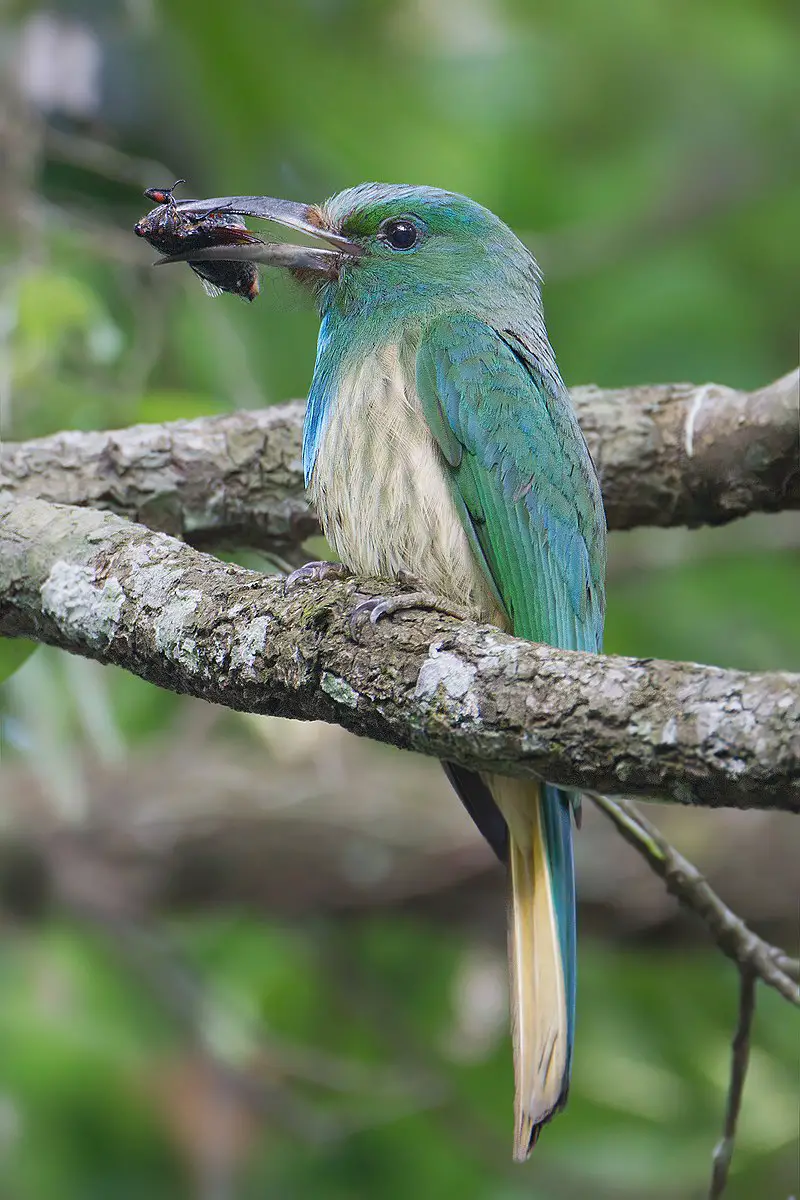
The blue-bearded bee-eater is a stunning species of bird found in the Indian subcontinent and parts of Southeast Asia.
This colorful avian is named for its distinctive throat feathers, which are long and often fluffed out to give it a particularly striking appearance.
The blue beard distinguishes this from other similar birds too. Blue-bearded bee eaters inhabit forest clearings and can be seen perching on branches or flying around looking for bees to snack on.
Their loud call can be heard echoing throughout their range, making them quite noticeable even when not visible.
Despite being widespread across much of the Malayan region, these beautiful birds remain under threat due to habitat loss and human interference with their natural environment – an important reminder that we must take care of our feathered friends as well as ourselves if we want them to continue gracing us with their presence in future generations.Scientific classification:
| Kingdom | Animalia |
| Phylum | Chordata |
| Class | Aves |
| Order | Coraciiformes |
| Family | Meropidae |
| Genus | Nyctyornis |
| Species | N. athertoni |
Also Featured In: Birds That You’ll See in Kaziranga National Park, Common Birds in Bangalore
14. White-Rumped Vulture
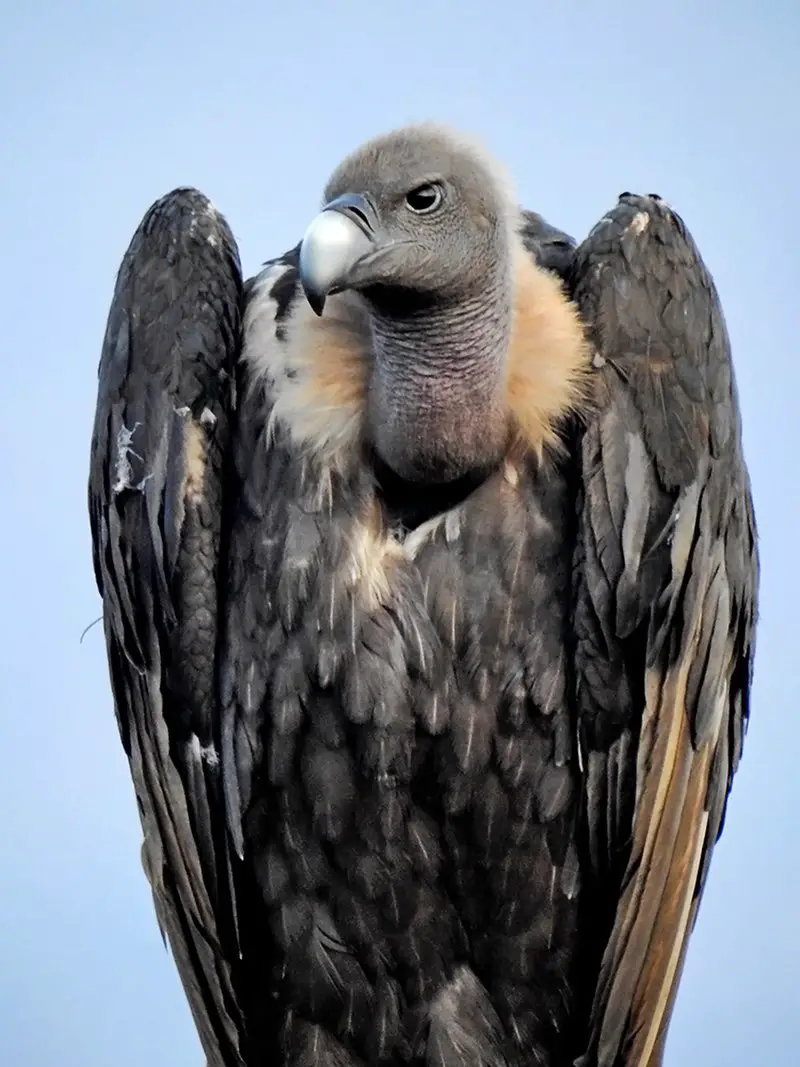
The white-rumped vulture is an Old World species found mainly in South and Southeast Asia. Sadly, it has been listed as Critically Endangered by the IUCN Red List since 2000 due to a severe decline in its population numbers.
The cause of this rapid drop is diclofenac poisoning which leads to kidney failure for these birds.
In the 1980s there were estimated to be several million individuals, but now their numbers have dropped drastically with some experts estimating them at fewer than 10 thousand breeding pairs left today.
Conservation efforts are underway across numerous countries to help save this unique species from extinction and raise awareness about the dangers posed by diclofenac pollution on wildlife populations around the world.Scientific classification:
| Kingdom | Animalia |
| Phylum | Chordata |
| Class | Aves |
| Order | Accipitriformes |
| Family | Accipitridae |
| Genus | Gyps |
| Species | G. bengalensis |
15. Blyth’s Kingfisher
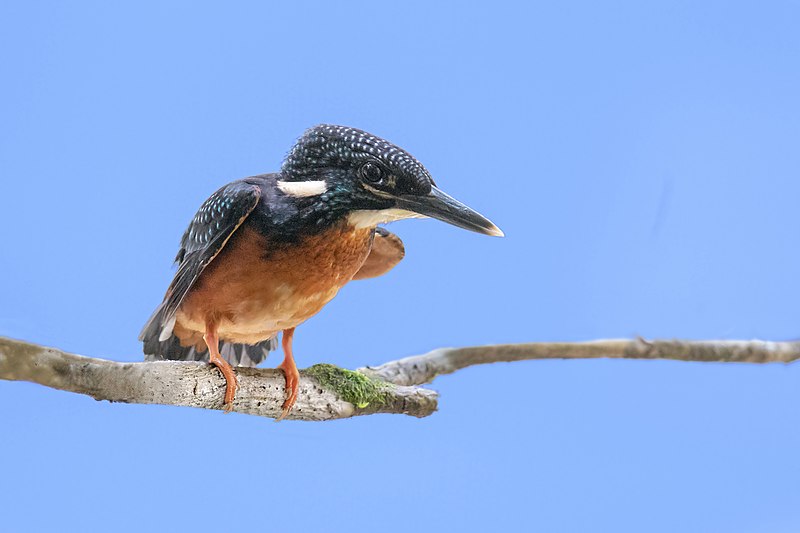
Blyth’s kingfisher, named after Edward Blyth, is the largest kingfisher in its genus Alcedo. It has an impressive size of 22-23 cm (8 5⁄8 and 9 in).
Its distinctive features include deep rufous underparts with a blackish blue breast patch, cobalt blue or azure upperparts tinged with purple and long bluish wings.
This aquatic bird loves to feed on fish which it catches by diving into water from a perch or while hovering over shallow waters.
The male attracts female mates through elaborate courtship rituals where they often fly together in pairs even during nesting season when the female builds their nest usually near water bodies like rivers and ponds.
With its vibrant colors this majestic species easily stands out against any backdrop making it one of nature’s most beautiful creatures.Scientific classification:
| Kingdom | Animalia |
| Phylum | Chordata |
| Class | Aves |
| Order | Coraciiformes |
| Family | Alcedinidae |
| Subfamily | Alcedininae |
| Genus | Alcedo |
| Species | A. hercules |
Also Featured In: Common Birds of Hainan,
16. Dark-Rumped Swift
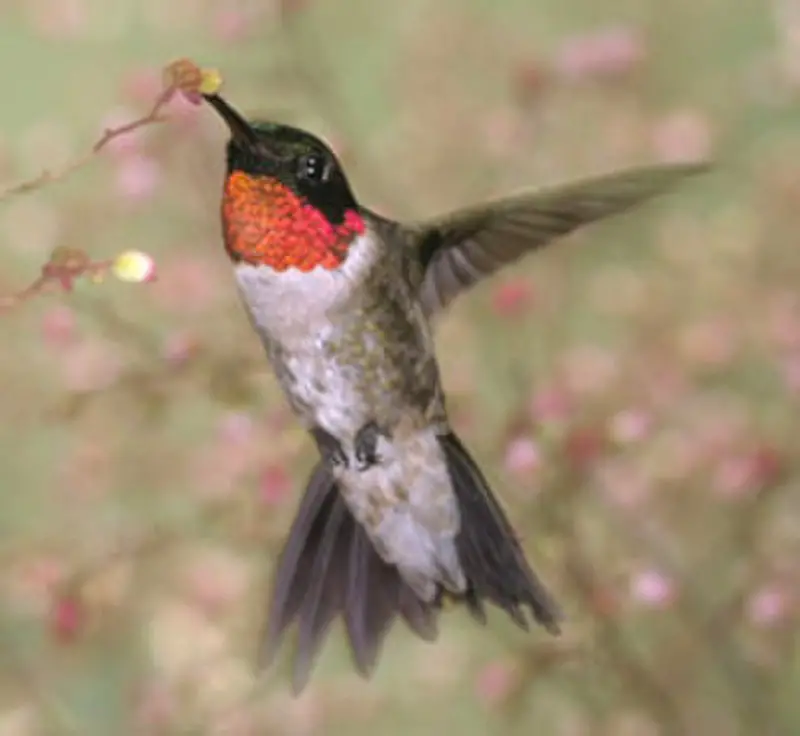
The dark-rumped swift is a species of bird belonging to the Apodidae family. It can be found in Bhutan, Northeast India and occasionally in Thailand as vagrants.
These birds inhabit subtropical or tropical moist lowland forests, but their population is diminishing due to habitat destruction caused by human activities such as deforestation and urbanization.
They are small birds with short wings, long tail feathers and pale grey underparts which distinguish them from other swifts.
This species has adapted well for aerial movement since it spends most of its life on the wing while hunting insects during flight.
The conservation status of this species is vulnerable because they are losing their natural habitats at an alarming rate due to manmade disturbances like industrialisation and mining operations that have resulted in large scale destruction of forest cover across much parts of Asia where these birds live naturally.Scientific classification:
| Kingdom | Animalia |
| Phylum | Chordata |
| Class | Aves |
| Order | Apodiformes |
| Family | Apodidae |
| Genus | Apus |
| Species | A. acuticauda |
17. Baer’s Pochard
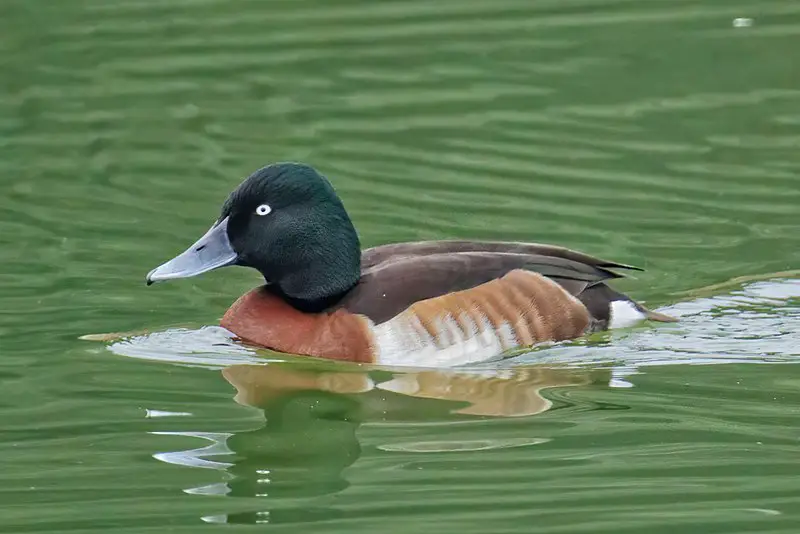
Baer’s pochard is a diving duck endemic to the eastern Asian region. It has an unmistakable black head and neck with green gloss, making it distinct from other species of ducks in the area.
This bird is mostly found in North and Central China but also migrates during winter months to southern China, Vietnam, Japan, and India as well as formerly bred in southeast Russia and Northeast China.
With its monotypic status, there are no subspecies of Baer’s pochard that have been identified yet by ornithologists.
The holotype for this specie was collected near the middle Amur River many years ago prior to its current distribution range being established today.
Its unique appearance makes it easily recognizable among other types of waterfowl inhabiting Asia bringing joy to those who spot them amongst their natural habitats.Scientific classification:
| Kingdom | Animalia |
| Phylum | Chordata |
| Class | Aves |
| Order | Anseriformes |
| Family | Anatidae |
| Genus | Aythya |
| Species | A. baeri |
18. Wood Snipe
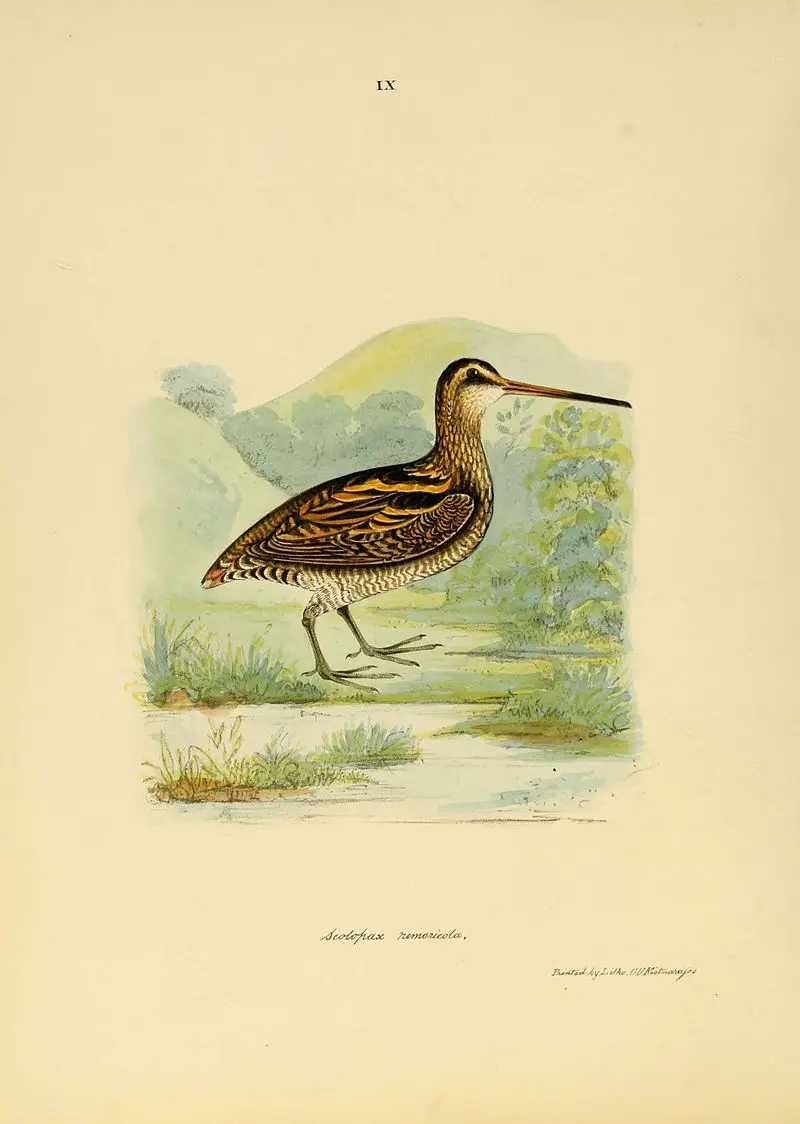
The Wood Snipe is a species of snipe found in the Himalayas from northern India, Nepal and Bhutan to southern China. It has dark plumage making it quite difficult to spot as it forages on open grasslands or wet meadows.
During winter months these birds travel down to lower altitudes in search for food where they are seen more commonly by bird watchers.
The Wood Snipe can also be spotted as an occasional vagrant throughout central and southern India, Sri Lanka, Bangladesh, Myanmar , North Thailand and Laos .
They feed mainly on insects which they pick up off the ground with their long bill while walking around looking for food.
In addition to this diet they are known to consume some vegetable matter such as seeds when available during winter seasonScientific classification:
| Kingdom | Animalia |
| Phylum | Chordata |
| Class | Aves |
| Order | Charadriiformes |
| Family | Scolopacidae |
| Genus | Gallinago |
| Species | G. nemoricola |
19. Lesser Fish Eagle
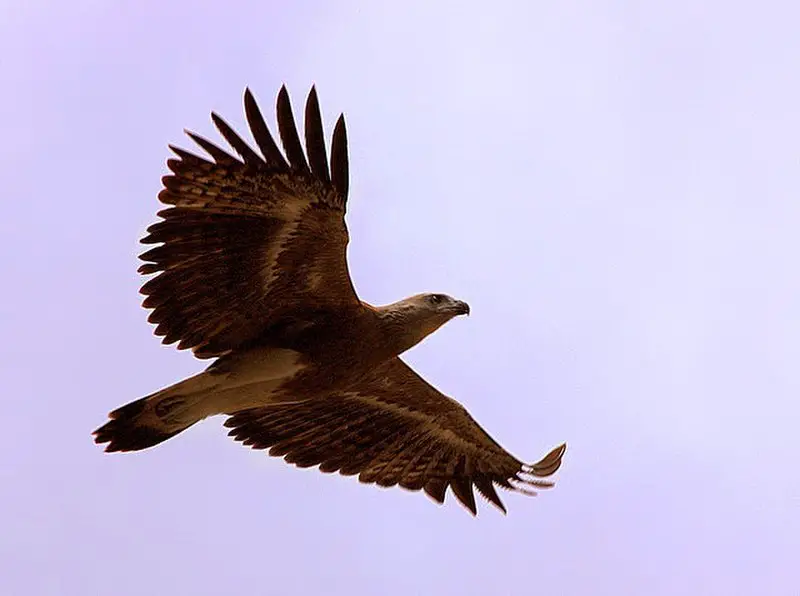
The lesser fish eagle is a species of Haliaeetus found in India and parts of Southeast Asia. It lives mainly in the Himalayan foothills, but there are reports from Gujarat, Central India and even Kaveri river valley in southern India.
This bird has dark brown upperparts with white head and underparts, marked by distinctive streaks on its breast.
Its wingspan ranges between 80-90 cm long and it feeds primarily on small fish which they catch while hovering over water bodies or swooping down swiftly to seize prey with their talons.
They nest near lakes or rivers where food is plentiful for them as well as their young ones; usually two eggs are laid at a time that hatch after an incubation period of 35 days.
The lesser fish eagle is considered vulnerable due to habitat destruction caused by human activities such us pollution or deforestation around its habitats leading to loss of nesting sites and food resources needed for survivalScientific classification:
| Kingdom | Animalia |
| Phylum | Chordata |
| Class | Aves |
| Order | Accipitriformes |
| Family | Accipitridae |
| Genus | Haliaeetus |
| Species | H. humilis |
20. Himalayan Cutia
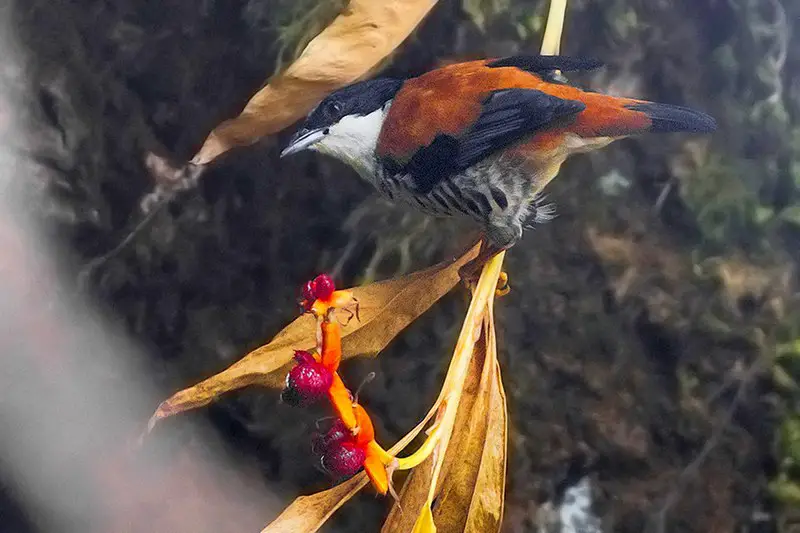
The Himalayan cutia is a small bird from the family Leiothrichidae, found in the Himalayan region. It gets its scientific name – Cutia nipalensis – from Nepali; ‘cuti’ being their word for this species of bird and ‘nipalensis’ meaning “from Nepal”.
This unique species can also be spotted in India, northern Thailand and Peninsular Malaysia. The cutting call they make while flying through the sky has become a sound of beauty to many people living nearby.
With an unmistakable pattern on its feathers along with bright red eyes, it’s no wonder that these birds are so loved by those who spot them.Scientific classification:
| Kingdom | Animalia |
| Phylum | Chordata |
| Class | Aves |
| Order | Passeriformes |
| Family | Leiothrichidae |
| Genus | Cutia |
| Species | C. nipalensis |
21. Bulbul
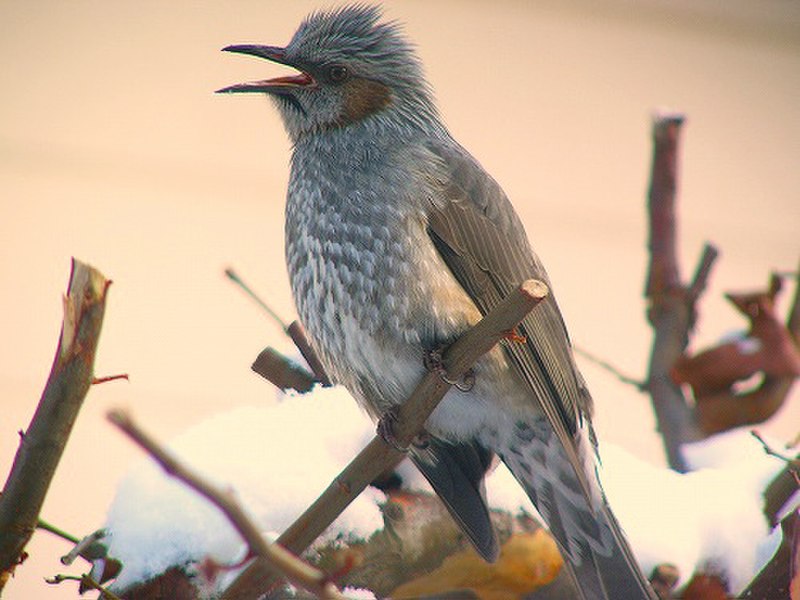
Bulbuls are a medium-sized passerine songbird family native to Africa, the Middle East and tropical Asia up until Japan. They can also be found on some of the Indian Ocean islands.
There are 160 species within 32 genera in this family which includes greenbuls, brownbuls, leafloves and bristlebills.
Bulbul birds have been known for their beautiful singing voices as well as for being very active during mating season when they gather together to create large flocks where potential mates can show off their skills.
The coloration of bulbuls range from dull greys or browns to vibrant yellows with black markings around the head region making them quite attractive creatures indeed.Scientific classification:
| Kingdom | Animalia |
| Phylum | Chordata |
| Class | Aves |
| Order | Passeriformes |
| Parvorder | Sylviida |
| Family | Pycnonotidae Gray, GR, 1840 |
22. Plumbeous Water Redstart
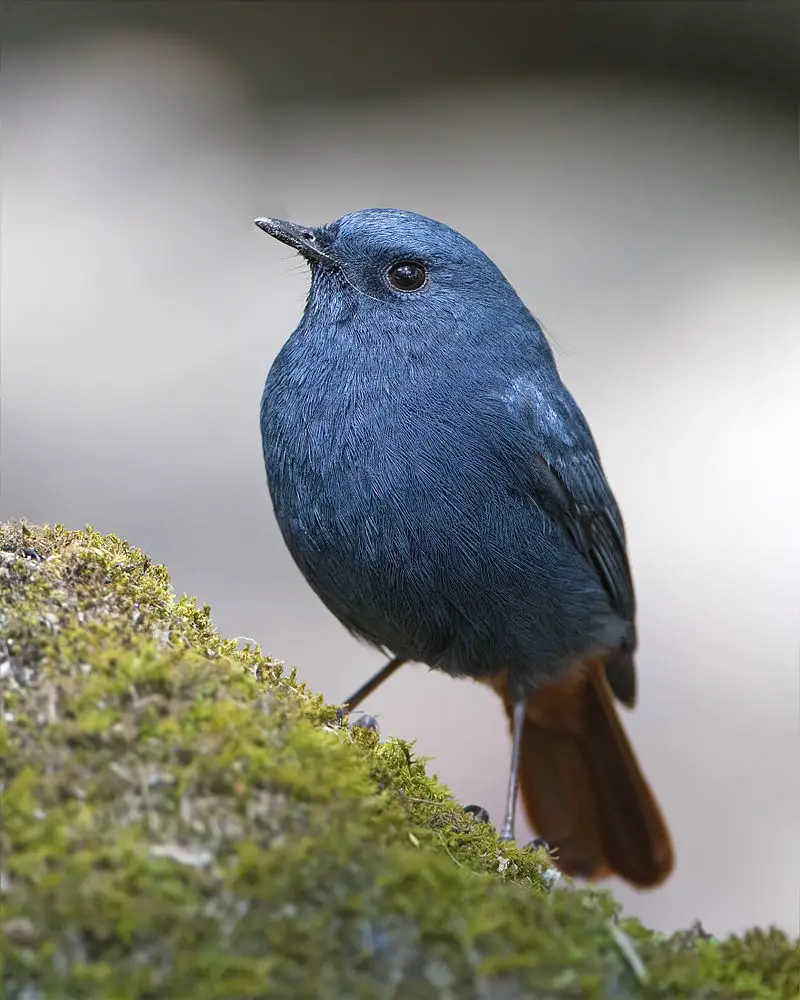
The Plumbeous Water Redstart is a beautiful passerine bird belonging to the Old World Flycatcher family. It can be found in South Asia, Southeast Asia and China, usually near fast-moving streams or rivers.
Males are slate blue while females have gray plumage with a slight reddish tinge on their wings. They also possess short tails and long legs which help them move swiftly over rocks by the water’s edge.
The name of this species comes from its lead-like colouring – ‘plumbeus’ meaning leaden in Latin.
These birds typically feed on insects such as grasshoppers, beetles and caterpillars that they catch by darting out from perches amongst boulders along streamsides or across roads like little flashes of lightening.Scientific classification:
| Kingdom | Animalia |
| Phylum | Chordata |
| Class | Aves |
| Order | Passeriformes |
| Family | Muscicapidae |
| Genus | Phoenicurus |
| Species | P. fuliginosus |
23. Red-Headed Bullfinch
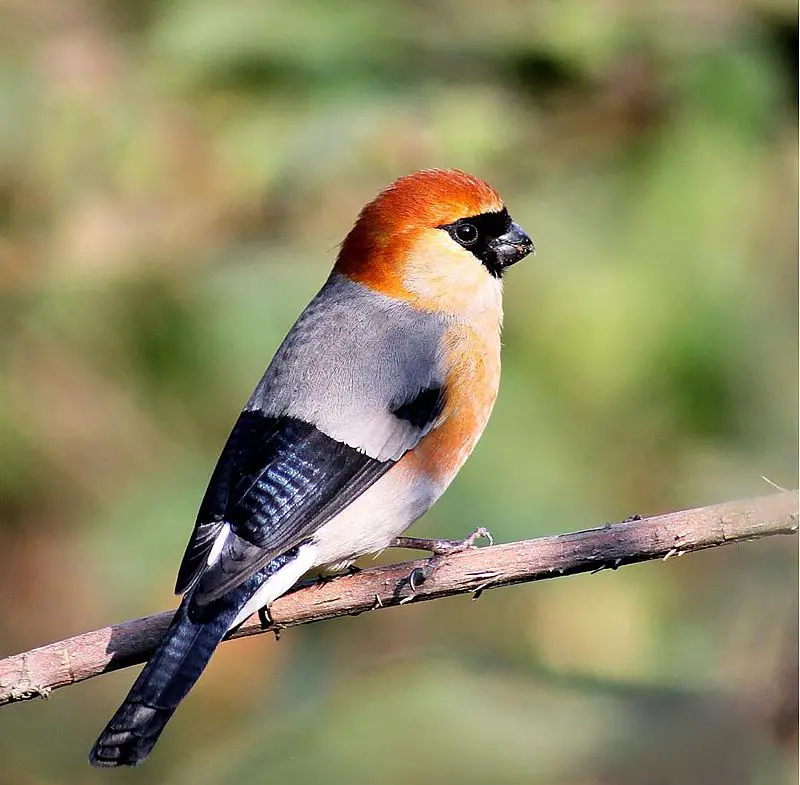
The Red-headed Bullfinch is an attractive small bird found in the Himalayas and adjacent highlands of Bhutan, northern India, Nepal and southern Tibet. It resides in temperate forests where it feeds on various seeds.
This species belongs to the finch family Fringillidae and its taxonomy was described by Arnaiz-Villena et al., 2001.
The ancestor of all birds within this genus (Pyrrhula) is P. erythrocephala which gives insight into how they are related genetically as well as geographically.
Its red head combined with a black face make for quite a striking appearance amongst other birds in their habitat – truly making them stand out from the crowd.
With proper conservation efforts, we may be able to keep this stunning little bird around for many generations to come.Scientific classification:
| Kingdom | Animalia |
| Phylum | Chordata |
| Class | Aves |
| Order | Passeriformes |
| Family | Fringillidae |
| Subfamily | Carduelinae |
| Genus | Pyrrhula |
| Species | P. erythrocephala |
24. Asian Emerald Cuckoo
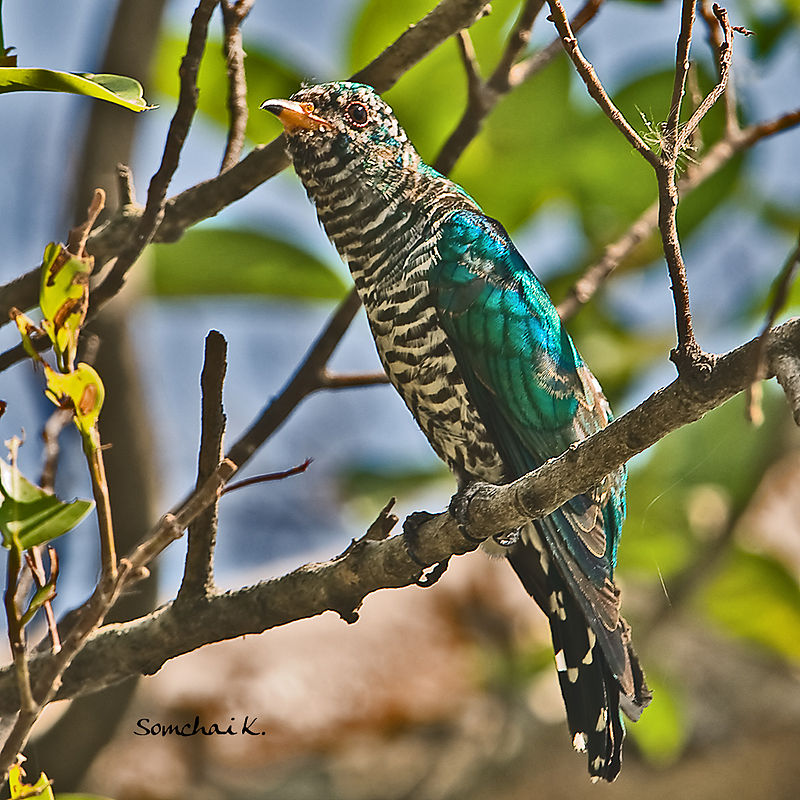
The Asian emerald cuckoo is a species of bird found in South and Southeast Asia. It has iridescent green feathers, with yellow underparts and white speckles along its wings.
Its call is an unmistakable high-pitched whistle that can be heard up to 1 km away. This unique sound serves as both warning signal for other birds, and attracts the attention of potential mates during breeding season.
The diet consists mainly of insects such as butterflies, moths, grasshoppers, flies etc., but they also eat fruits like figs when available.
They prefer lowland or montane forests where there are plenty of trees for them to nest in.
Although their numbers have been declining due to deforestation and hunting pressure from humans; governments across the region are now taking steps to protect this beautiful creature so it may continue thriving in our forests for generations to come.Scientific classification:
| Kingdom | Animalia |
| Phylum | Chordata |
| Class | Aves |
| Order | Cuculiformes |
| Family | Cuculidae |
| Genus | Chrysococcyx |
| Species | C. maculatus |
25. Rusty-Flanked Treecreeper
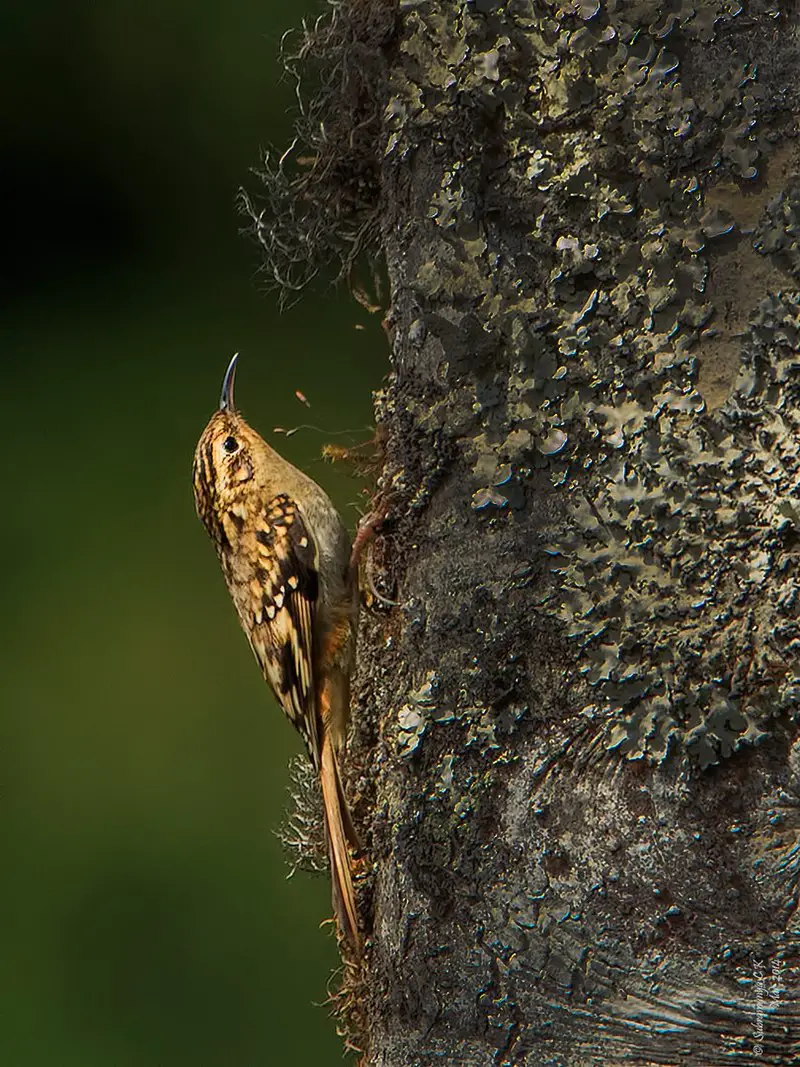
The Rusty-flanked Treecreeper is a small species of bird belonging to the family Certhiidae. It is found in northern India, Nepal, Bhutan and western Yunnan where it inhabits boreal forests and temperate forests.
With its reddish flanks and distinctive black stripe along its back, this treecreeper stands out from other birds with similar appearance.
Its diet consists mainly of insects which they search for on tree trunks using their curved beaks to probe under bark or into crevices.
They are primarily seen alone as they hunt but can sometimes be observed in pairs or small groups when migrating seasonally between regions depending upon food availability.
The Rusty-flanked Treecreeper has an important role in maintaining healthy forest ecosystems by helping control insect populations that could otherwise cause damage to trees if left uncheckedScientific classification:
| Kingdom | Animalia |
| Phylum | Chordata |
| Class | Aves |
| Order | Passeriformes |
| Family | Certhiidae |
| Genus | Certhia |
| Species | C. nipalensis |
26. Snow Pigeon
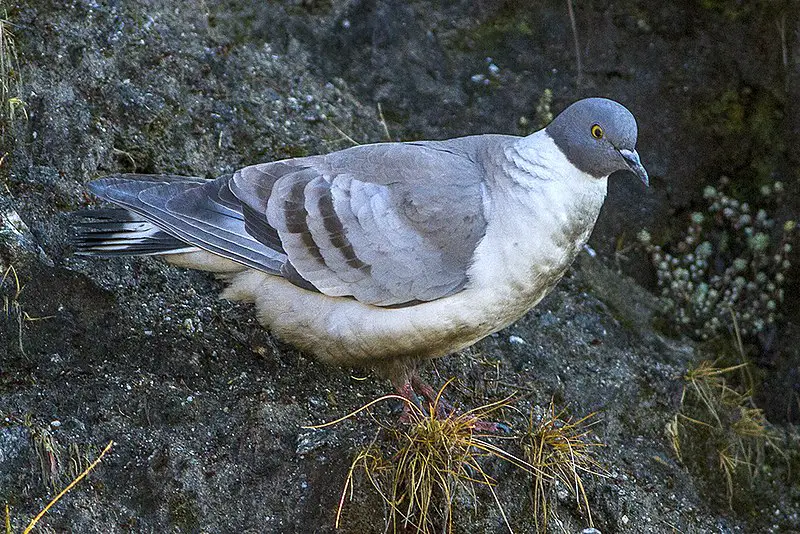
The snow pigeon is a species of bird found in hilly regions of Central Asia. It has various colors such as grey, black, pale brown and white with two subspecies recognised.
The western Himalayas from Western Afghanistan to Sikkim are the home for C. l. leuconota while C. l gradaria lives in eastern Tibet and Eastern Nan Shan (Qinghai).
These birds inhabit open grasslands or scrub forests where they feed on grains and seeds by walking along the ground like most other pigeons do.
They also take insects when available through out their range during summer months due to its catholic diet habits it can survive hostile conditions easily which makes them quite hardy species.Scientific classification:
| Kingdom | Animalia |
| Phylum | Chordata |
| Class | Aves |
| Order | Columbiformes |
| Family | Columbidae |
| Genus | Columba |
| Species | C. leuconota |
27. Black-Faced Laughingthrush
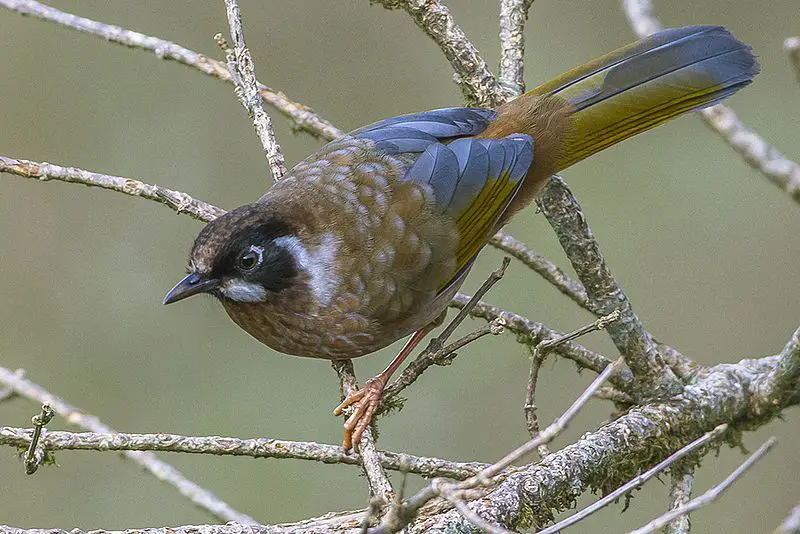
The black-faced laughingthrush is a species of bird belonging to the Leiothrichidae family, found in the Eastern Himalayas.
Its range stretches from Nepal eastwards towards India and Myanmar, with disjunct populations appearing further south in continental Southeast Asia.
These birds are medium sized with greyish brown backs and buff underparts that contrast their striking jet-black face patch.
They have white eye stripes which extend farther down than most other Trochalopteron species do; its bill is also noticeably slender compared to other members of this genus.
Their diet consists mainly of insects such as beetles, ants and grasshoppers but they will partake in fruit when it’s seasonally available too.
The black-faced laughingthrush makes an interesting garden visitor if you’re lucky enough to spot one near your location.Scientific classification:
| Kingdom | Animalia |
| Phylum | Chordata |
| Class | Aves |
| Order | Passeriformes |
| Family | Leiothrichidae |
| Genus | Trochalopteron |
| Species | T. affine |
28. White-Browed Bush Robin
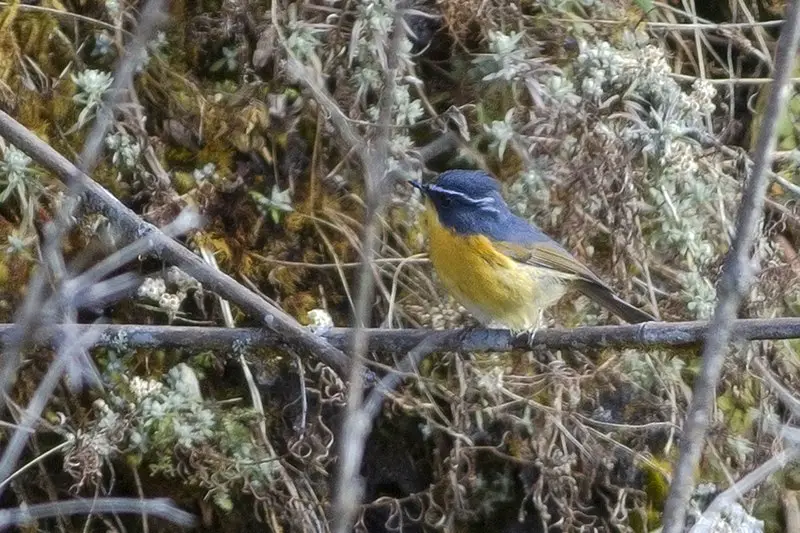
The White-browed Bush Robin is a species of bird found in the Himalayas, south-central China and Taiwan. It lives mainly in Rhododendron and conifer forests.
The subspecies formosanus distributed solely in Taiwan was first described by Ernst Hartert in 1910, but it has since been proposed as its own full species called the Taiwan Bush Robin.
This small bird features brown upperparts with white spots on wings and tail feathers, while its underparts are white with greyish bands along sides of breast.
Its face shows an eye ring composed of blackish stripes surrounding yellow eyes that contrast against its brown forehead and crown which give this robin its name; “White-Browed”.
They feed mainly on insects near ground or among foliage during day time hours.Scientific classification:
| Kingdom | Animalia |
| Phylum | Chordata |
| Class | Aves |
| Order | Passeriformes |
| Family | Muscicapidae |
| Genus | Tarsiger |
| Species | T. indicus |
29. Rufous-Bellied Woodpecker
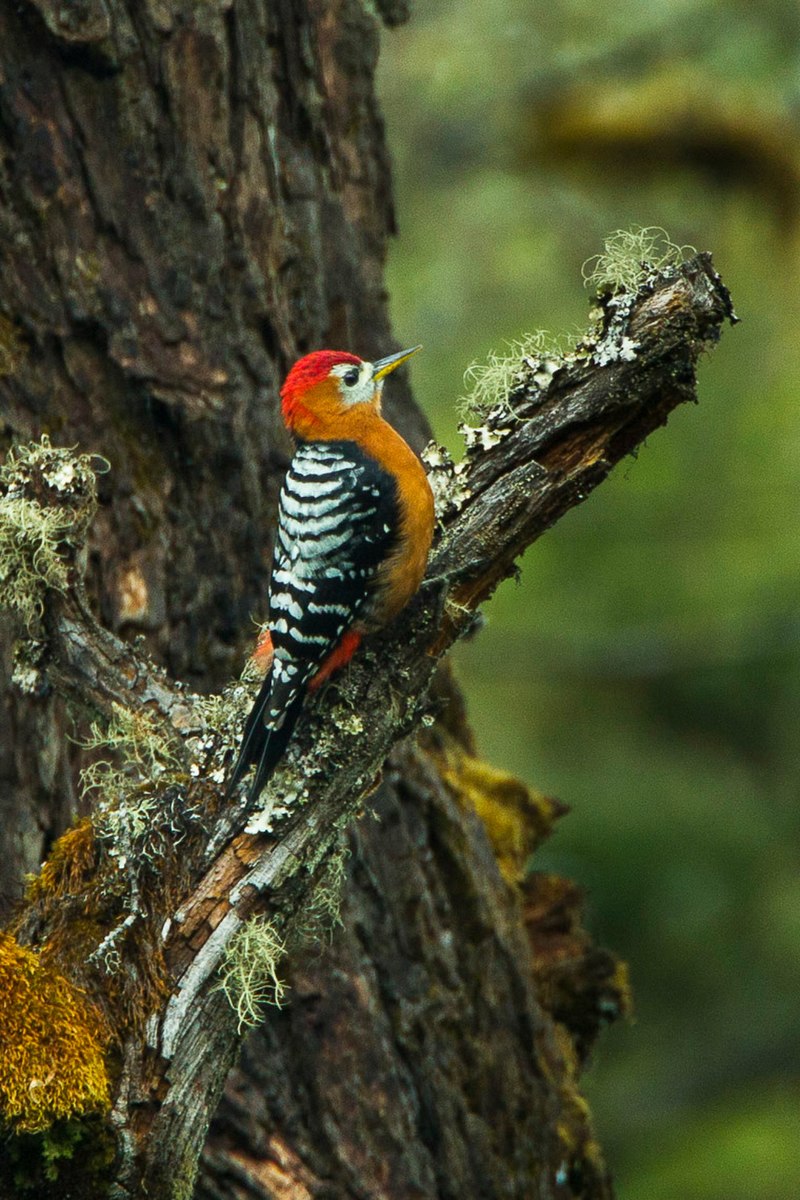
The Rufous-bellied woodpecker is a species of bird that belongs to the Picidae family. It can be found in Bangladesh, Bhutan and India throughout Southeast Asia along the Himalayas.
Its unique behavior often leads it to being confused with an Asiatic sapsucker as they frequently make small pits on trees’ bark which give them their name.
This species has a brownish backside contrasted with its rufous colored belly, wings and tail feathers as well as white markings across its face giving it unmistakable features amongst other birds in this region.
With large eyes located at the sides of its head, these woodpeckers have excellent vision allowing them to find insects hidden beneath tree bark while they search for food or build nests during mating season.Scientific classification:
| Kingdom | Animalia |
| Phylum | Chordata |
| Class | Aves |
| Order | Piciformes |
| Family | Picidae |
| Genus | Dendrocopos |
| Species | D. hyperythrus |
30. Rufous Sibia
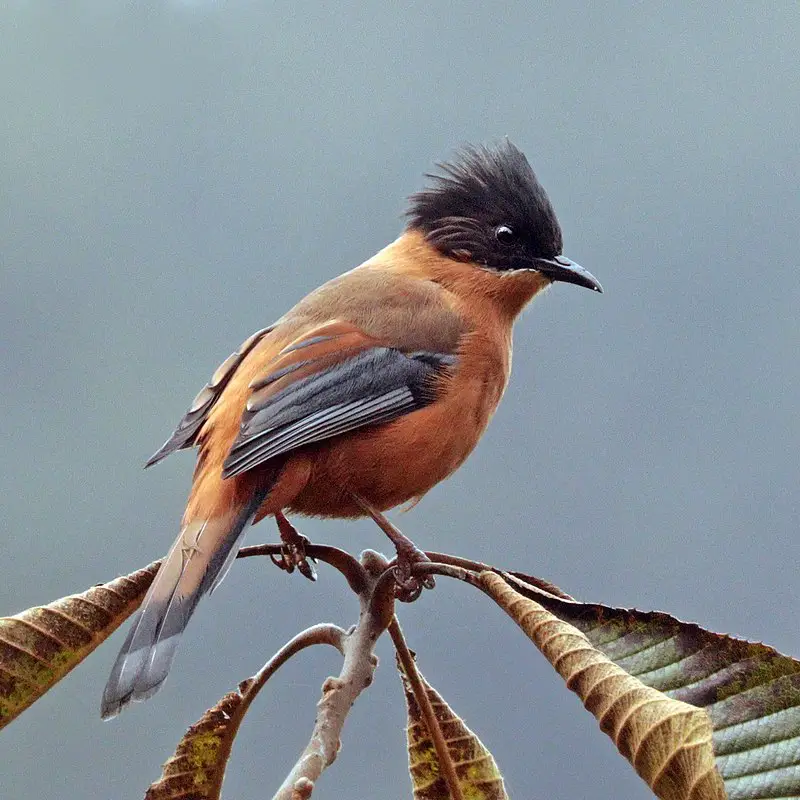
The Rufous Sibia is a rare bird found in the northern parts of India, Nepal and Bhutan. It has an unmistakable appearance with its rufous-dominated colouration and distinctive white facial markings that distinguish it from other birds.
The species feeds on berries, insects, as well as nectar from flowers.
This small but beautiful bird inhabits temperate forests of the Lower to Middle Himalayas where it can be seen flitting around tree branches or perched atop rocks looking for food.
As their natural habitats get increasingly disturbed by human activities such as logging and farming, these birds are becoming more vulnerable due to decreased availability of resources resulting in their dwindling population numbers.
Conservation efforts must thus focus on protecting this unique species before they become extinct forever.Scientific classification:
| Kingdom | Animalia |
| Phylum | Chordata |
| Class | Aves |
| Order | Passeriformes |
| Family | Leiothrichidae |
| Genus | Heterophasia |
| Species | H. capistrata |
31. Black-Backed Forktail
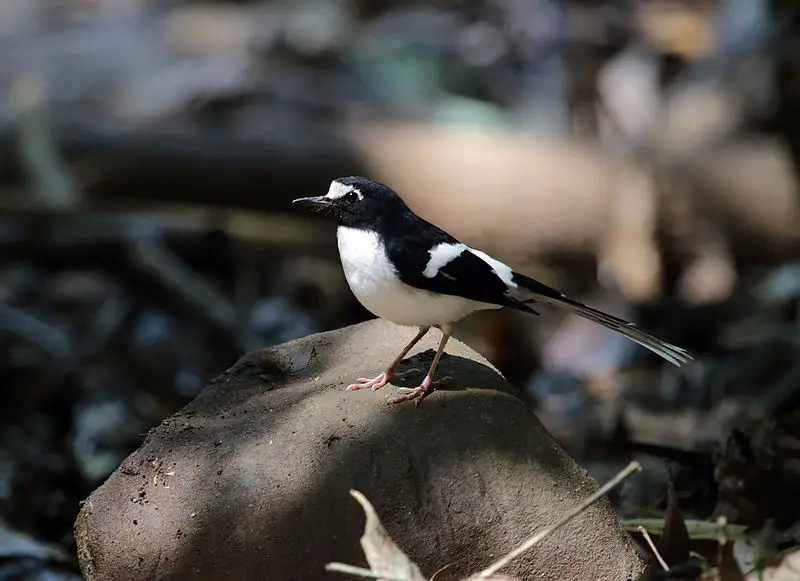
The Black-backed forktail is a species of bird belonging to the Muscicapidae family. It was first described in 1836, from specimens collected in Nepal and can be identified by its medium size weighing between 25 and 29 grams with a length of 20.5 to 23 centimetres (8 1⁄8 to 9 in).
This species has an easily recognizable broad white stripe across its back which gives it its name.
The upperparts are dark greyish brown while the underparts have slightly paler feathers that may show light streaking on some areas such as their breast or throat area.
Its tail is long, black above with two prominent white bars at the tip; below they are rufous coloured with faint barring near tips of outer webs too.
Other features include yellow eyes and legs, small bill and short wingspan for quick manoeuvring through dense foliage during flightScientific classification:
| Kingdom | Animalia |
| Phylum | Chordata |
| Class | Aves |
| Order | Passeriformes |
| Family | Muscicapidae |
| Genus | Enicurus |
| Species | E. immaculatus |
32. Collared Falconet
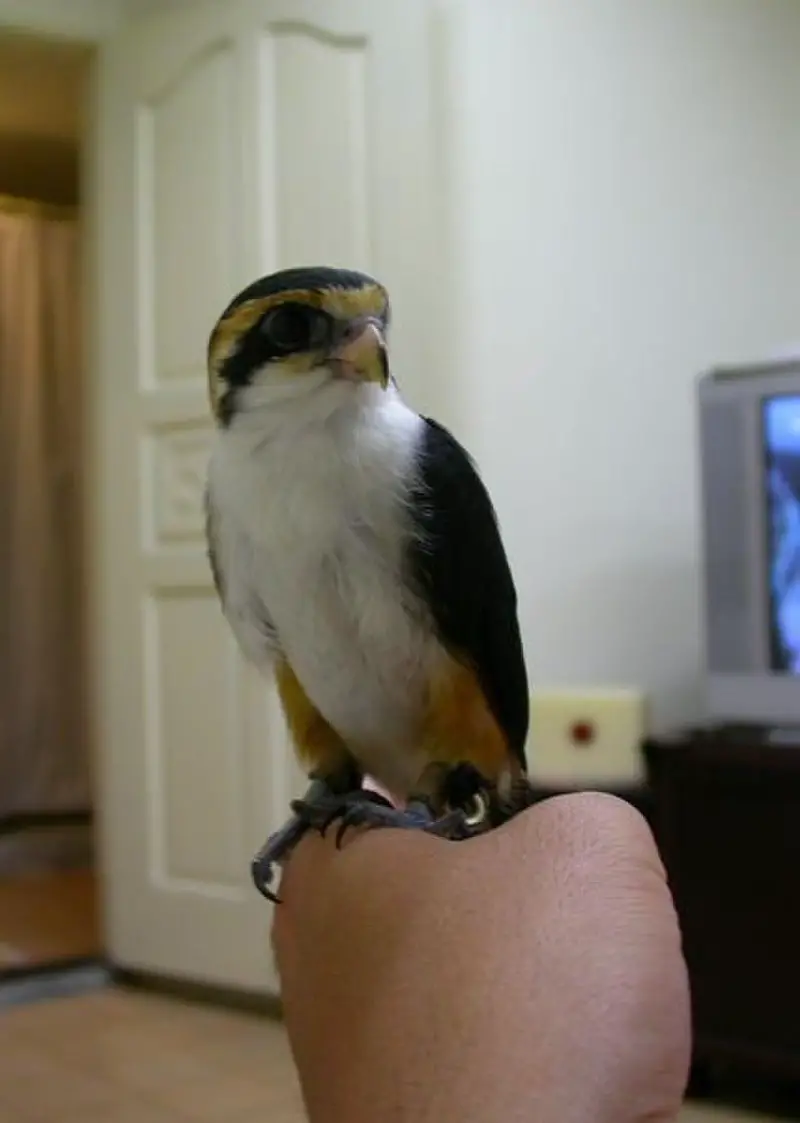
The Collared Falconet is a species of bird of prey belonging to the family Falconidae.
It is found mainly in parts of Southeast Asia and India, including Bangladesh, Bhutan, Cambodia, India, Laos Myanmar Nepal Thailand Malaysia and Vietnam.
It has an average length of 18 cm (7.1 inches). Its natural habitat consists mostly of temperate forest edges with broadleaf forests.
This small falcon usually hunts by rapidly beating its wings as it moves around in search for food like insects or lizards on branches or trees nearby.
The Collared Falconet’s diet also includes small birds such as doves and finches which it catches mid-air after diving from great heights at high speeds if need be.Scientific classification:
| Kingdom | Animalia |
| Phylum | Chordata |
| Class | Aves |
| Order | Falconiformes |
| Family | Falconidae |
| Genus | Microhierax |
| Species | M. caerulescens |
33. Fire-Tailed Sunbird
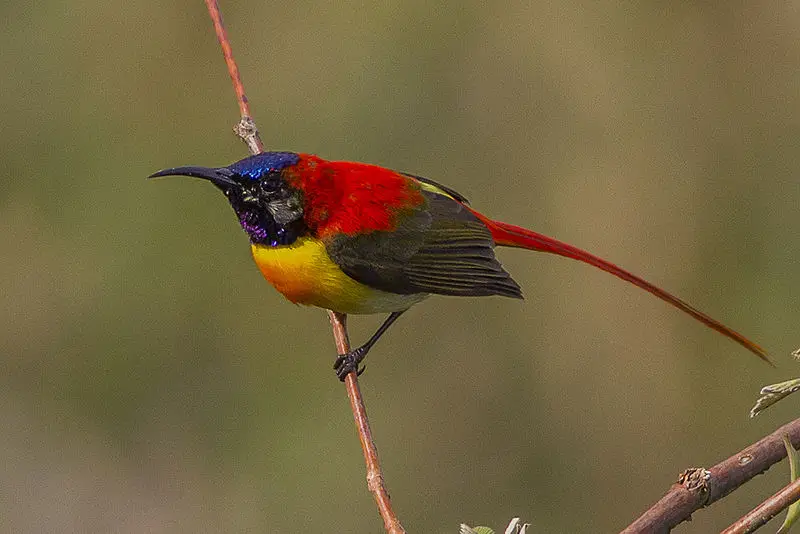
The Fire-tailed Sunbird is a stunning species of sunbird that can be found in the northern parts of India, Bangladesh, Bhutan, Myanmar, Nepal and Tibet.
It typically inhabits temperate forests and subtropical or tropical areas. This bird has an attractive appearance with its bright yellow chestnut head crest along with its red tail feathers.
The males possess long metallic green upperparts whereas females have brownish grey plumage on their backside.
Also they both feature reddish bills which are used to feed nectar from flowers as well as small insects like flies and grasshoppers for protein consumption .
They prefer to build nests high up near streamsides where water sources are easily accessible during all seasons of the year making it easier for them to survive in harsh climates during winter monthsScientific classification:
| Kingdom | Animalia |
| Phylum | Chordata |
| Class | Aves |
| Order | Passeriformes |
| Family | Nectariniidae |
| Genus | Aethopyga |
| Species | A. ignicauda |
34. Dark-Breasted Rosefinch
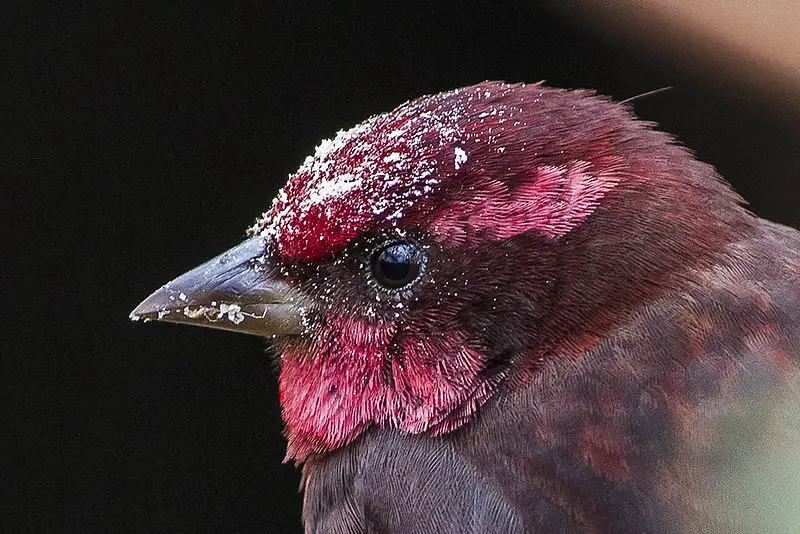
The Dark-breasted Rosefinch is a stunning species of true finch found across Asia in countries such as Bhutan, China, India, Laos and Vietnam.
This small bird has an unmistakable plumage with its dark brown chest contrasted against light grey wings and tail feathers.
It inhabits boreal forests and subtropical or tropical high-altitude shrublands where it feeds on seeds from pine trees as well as insects.
The genus Procarduelis was created specifically for this species because of their unique features which differ from other true finches like the House Finch or Goldfinches.
They are social birds that form tight flocks when searching for food sources throughout winter months but during breeding season they become more solitary creatures yet remain loyal to the same nesting sites year after year.Scientific classification:
| Kingdom | Animalia |
| Phylum | Chordata |
| Class | Aves |
| Order | Passeriformes |
| Family | Fringillidae |
| Subfamily | Carduelinae |
| Genus | Procarduelis Blyth, 1843 |
| Species | P. nipalensis |
35. Dark-Rumped Rosefinch
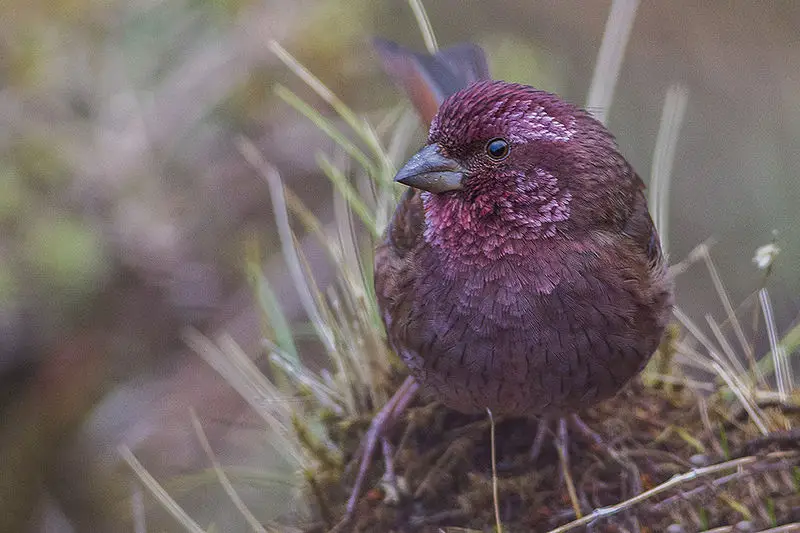
The Dark-rumped Rosefinch is a beautiful species of finch found in several countries such as Bhutan, China, India, Myanmar and Nepal. This bird usually inhabits boreal forests and subtropical or tropical high-altitude shrubland areas.
Its plumage is mainly dull brown with white patches on its wings and tail feathers which gives it an elegant appearance.
It also has a bright pinkish red head that distinguishes it from other species of birds; this feature makes them stand out among their surroundings.
These birds are generally active during the day but can be seen foraging around dusk too when they look for food such as seeds, fruits and insects to feed upon.
The Dark-rumped Rosefinch is considered to be fairly common in some parts of its range however due to habitat destruction caused by human activities their numbers have been declining at alarming rates thus making them vulnerable towards extinction if nothing changes soon.Scientific classification:
| Kingdom | Animalia |
| Phylum | Chordata |
| Class | Aves |
| Order | Passeriformes |
| Family | Fringillidae |
| Subfamily | Carduelinae |
| Genus | Carpodacus |
| Species | C. edwardsii |
36. Blanford’s Rosefinch
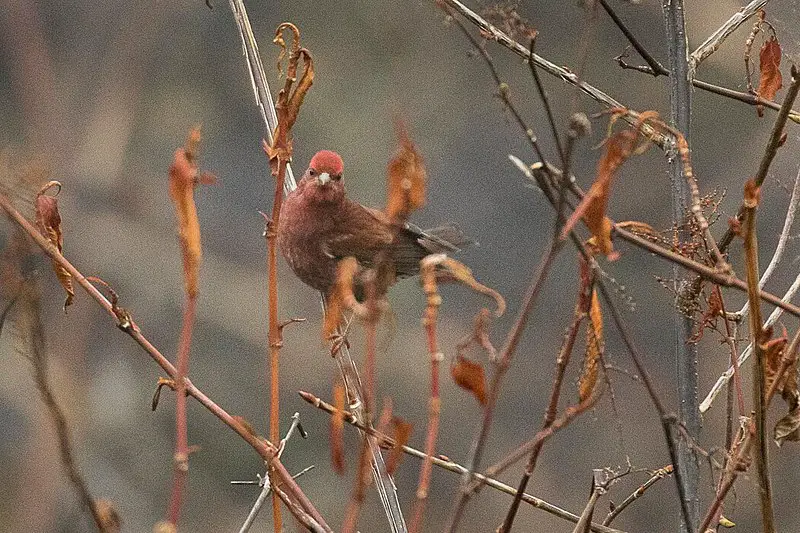
Blanford’s rosefinch is a species of finch found in Bhutan, China, India and Nepal. They inhabit boreal forests and were formerly placed in the genus Carpodacus with other rosefinches.
However, recent phylogenetic analysis shows that they are distinct enough to be classified as their own monotypic genus Agraphospiza.
These birds have striking crimson feathers which make them stand out from other nearby species.
Their diet mainly consists of seeds but also includes nuts, fruits and insects when available during breeding season.
Blanford’s Rosefinch has an interesting habitat preference; while usually seen near coniferous trees they can often be spotted around human habitations such as farmsteads or gardens due to their fondness for cultivated grains like wheat or millet.Scientific classification:
| Kingdom | Animalia |
| Phylum | Chordata |
| Class | Aves |
| Order | Passeriformes |
| Family | Fringillidae |
| Subfamily | Carduelinae |
| Genus | Agraphospiza Zuccon, Prŷs-Jones, Rasmussen & Ericson, 2012 |
| Species | A. rubescens |
37. Brown Bush Warbler
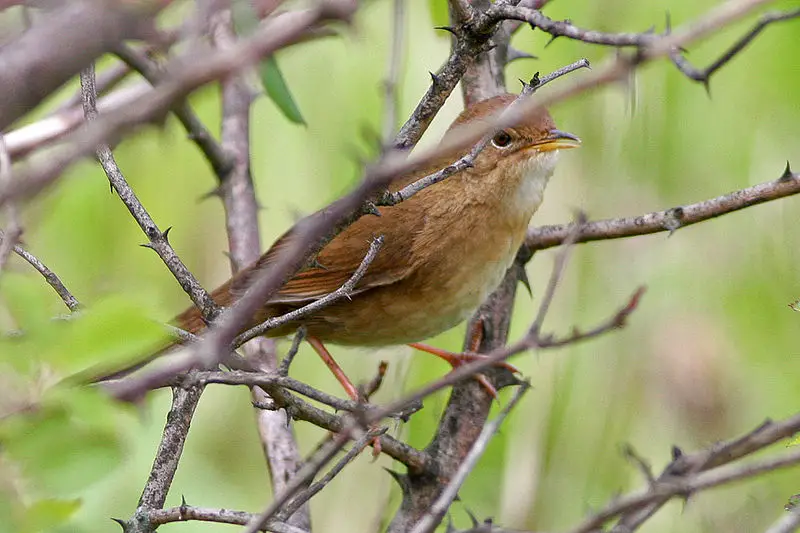
The Brown Bush Warbler is a songbird species that belongs to the newly recognized family Locustellidae. It can be found in parts of Bangladesh, Bhutan, China, Hong Kong, India, Myanmar, Nepal Thailand and Vietnam.
During breeding season it inhabits boreal forests while during other times of the year subtropical and tropical areas are preferred habitats.
This small bird has brownish upperparts with white underparts striped dark on sides as well as wings which are barred black-and-white above and plain grey below.
The bill is short but broad compared to other warblers making them easily recognizable among their peers.Scientific classification:
| Kingdom | Animalia |
| Phylum | Chordata |
| Class | Aves |
| Order | Passeriformes |
| Family | Locustellidae |
| Genus | Locustella |
| Species | L. luteoventris |
38. Black-Headed Shrike-Babbler
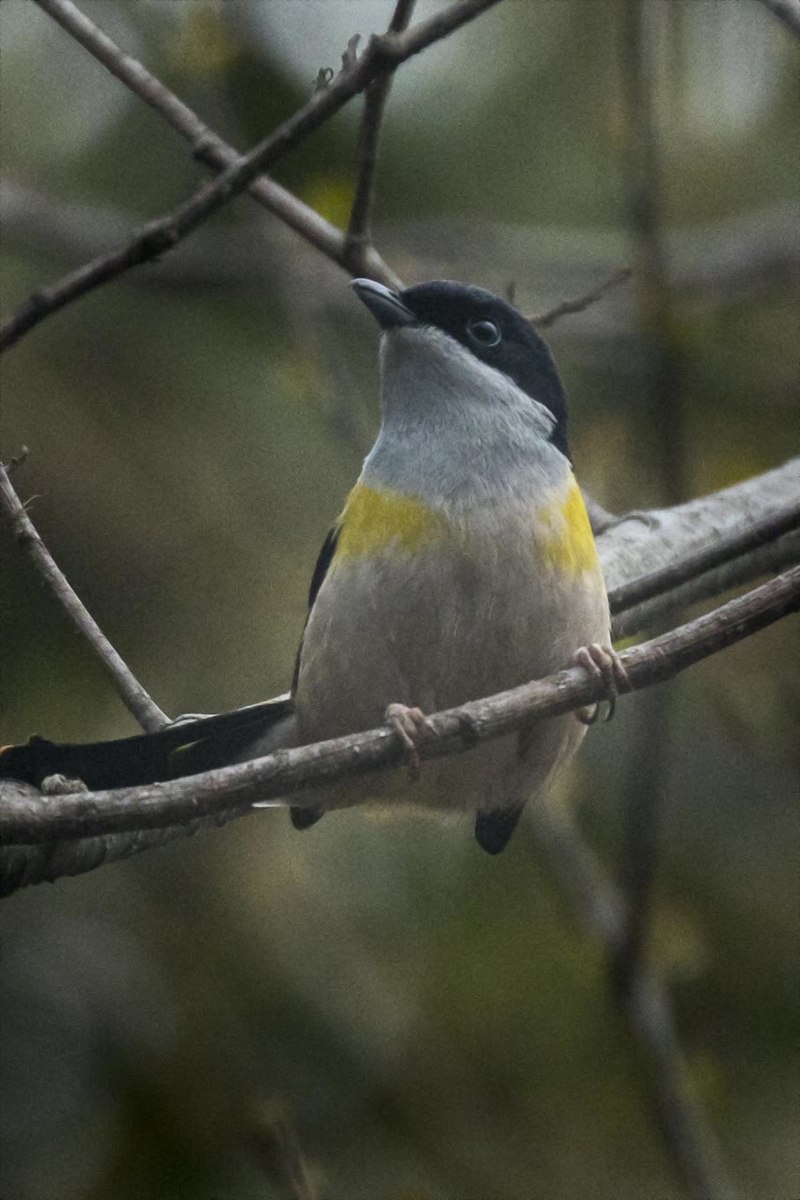
The Black-headed shrike-babbler is a small and beautiful bird found in the forests of eastern Nepal to northwestern Vietnam.
It belongs to either Old World babblers, Timaliidae family or Eurasian vireos, Vireonidae family.
This species inhabits subtropical or tropical moist montane forests which are rich with vegetation and food sources for it.
Its head has an attractive black colouration while its body is covered in brown feathers having white spots on them.
The diet of this bird consists mainly of insects such as beetles, caterpillars, grasshoppers etc., but it also feeds on fruits occasionally too.
In recent years due to deforestation their numbers have been decreasing rapidly so they are listed under Near Threatened status by IUCN Red List conservation programScientific classification:
| Kingdom | Animalia |
| Phylum | Chordata |
| Class | Aves |
| Order | Passeriformes |
| Family | Vireonidae |
| Genus | Pteruthius |
| Species | P. rufiventer |
39. Black-Chinned Yuhina
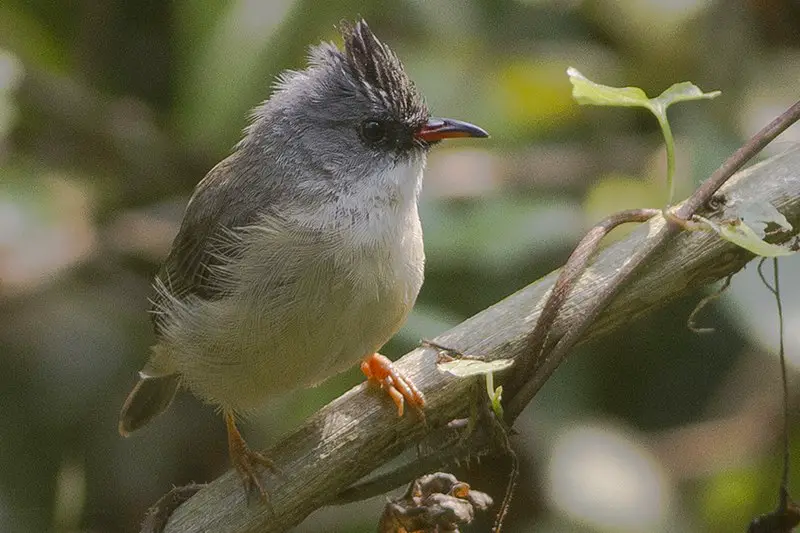
The Black-chinned Yuhina is a small bird belonging to the white-eye family Zosteropidae.
It can be found in various parts of India and Southeast Asia, from Himalayan regions eastward down through Bangladesh, Bhutan, Cambodia, Laos , Myanmar Nepal Tibet and Thailand.
These birds prefer subtropical or tropical moist lowland forests for their habitat where they feed on insects like termites that are commonly found there.
In addition to being active during day time hours these little creatures often form large flocks with other species like barbets and cuckoos when looking for food sources.
They have remarkable black chins which distinguishes them among other members of this family making them quite unique.Scientific classification:
| Kingdom | Animalia |
| Phylum | Chordata |
| Class | Aves |
| Order | Passeriformes |
| Family | Zosteropidae |
| Genus | Yuhina |
| Species | Y. nigrimenta |
40. Red-Faced Liocichla
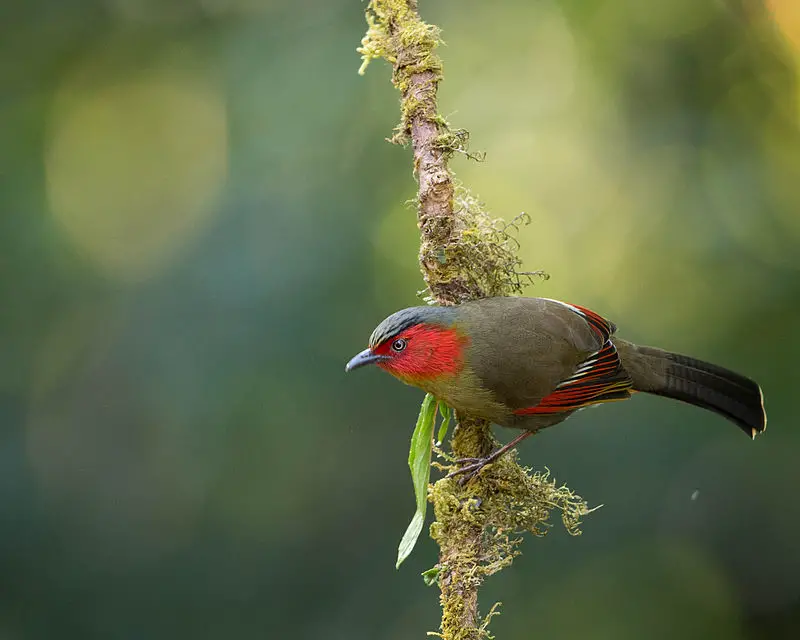
The Red-faced Liocichla is a species of bird belonging to the Leiothrichidae family. It inhabits subtropical and tropical, moist montane forests in Bangladesh, Bhutan, Myanmar, Northeast India Nepal and western Yunnan.
When foraging through dense undergrowth of broadleaf forest it can be seen either alone or in pairs as well as flocks with other birds.
Thanks to its striking red face patch this species has become quite popular among birdwatchers all around the world who are eager to spot one during their travels.
The diet mainly consists on fruits but they also eat small insects ans spiders too when available. Despite being fairly common across its range due to deforestation these birds may disappear from many areas if conservation efforts aren’t taken soon enough.Scientific classification:
| Kingdom | Animalia |
| Phylum | Chordata |
| Class | Aves |
| Order | Passeriformes |
| Family | Leiothrichidae |
| Genus | Liocichla |
| Species | L. phoenicea |
41. Yellow-Cheeked Tit
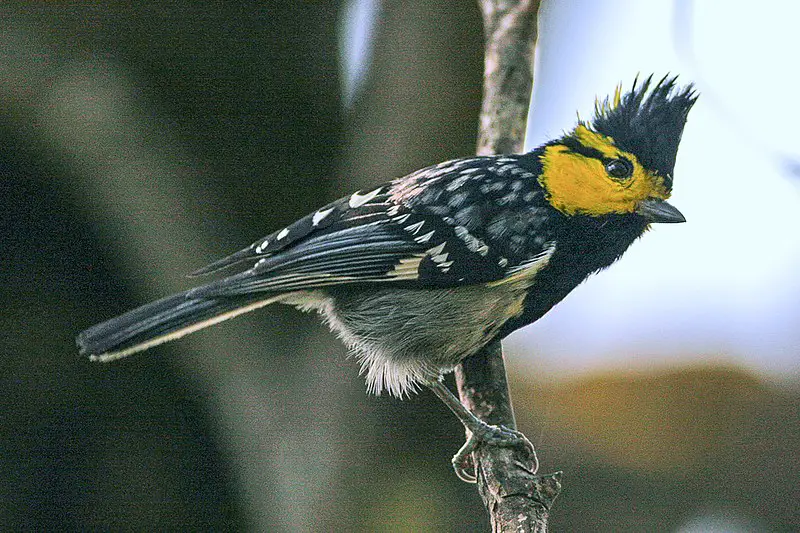
The yellow-cheeked tit is a species of bird found in Bangladesh, Bhutan, China and other parts of Asia. It inhabits subtropical or tropical lowland forests and montane forests.
The male has distinctive bright yellow cheeks that contrast sharply with the black crown on its head but the female’s plumage is generally drabber than the males’.
They are very active birds, often flitting about from tree to tree searching for insects, seeds and berries which make up their diet.
Their nests consist of small cups made out of grasses built high in trees near water sources such as streams or rivers.
These colourful little birds may be seen alone or in small groups throughout much of Southeast Asia where they are not considered threatened due to their wide range and large population numbers.Scientific classification:
| Kingdom | Animalia |
| Phylum | Chordata |
| Class | Aves |
| Order | Passeriformes |
| Family | Paridae |
| Genus | Machlolophus |
| Species | M. spilonotus |
42. Grey-Crowned Prinia
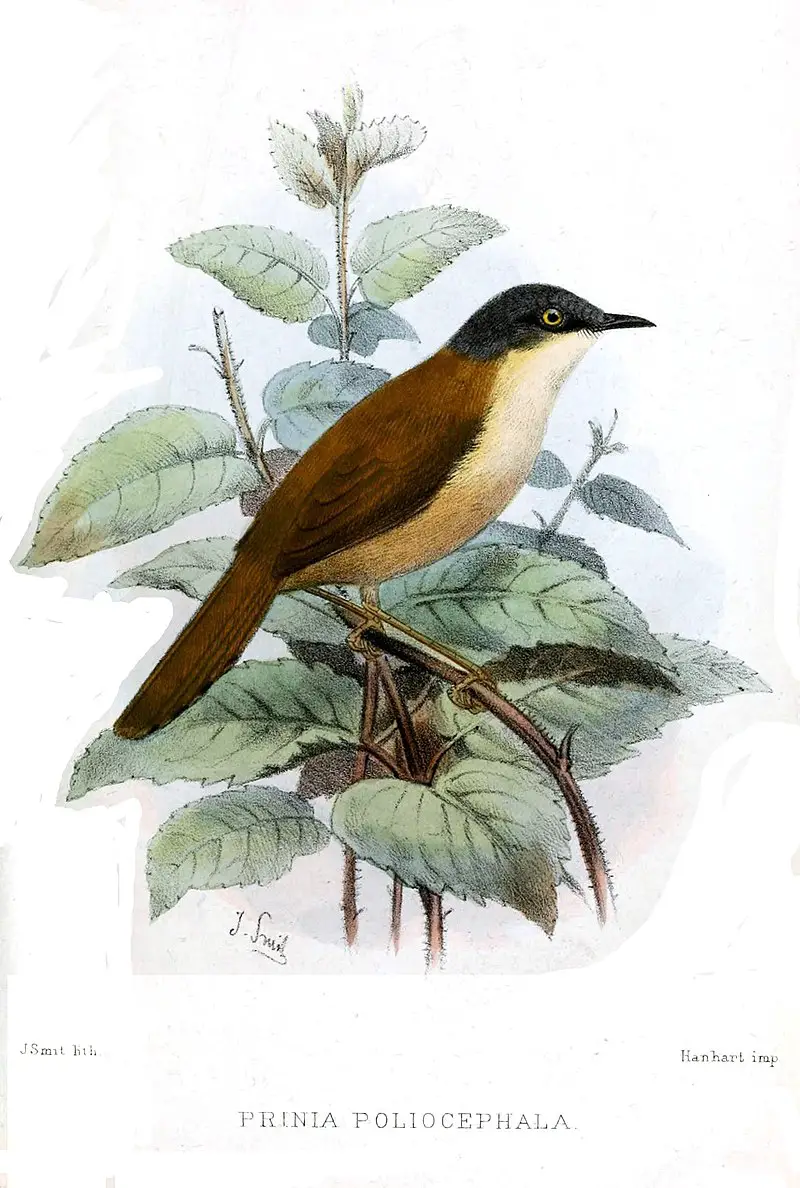
The Grey-crowned Prinia is a species of bird found in Bhutan, northern India and Nepal. It inhabits dry forests, shrubland and grassland habitats as well as arable land.
Its plumage consists of greyish brown upperparts with white underparts streaked with gray or black barring on the breast sides. It has a distinctive grey crown that distinguishes it from other birds in its family Cisticolidae.
Unfortunately this species faces threats due to habitat destruction caused by human activities such as agriculture and urban development which can cause fragmentation of their natural habitats leaving them vulnerable to predation or displacement from native food sources.
Despite these challenges, conservation efforts are being made to protect this beautiful bird so future generations can enjoy its presence in the wild for many years to come.Scientific classification:
| Kingdom | Animalia |
| Phylum | Chordata |
| Class | Aves |
| Order | Passeriformes |
| Family | Cisticolidae |
| Genus | Prinia |
| Species | P. cinereocapilla |
43. Blue-Throated Blue Flycatcher
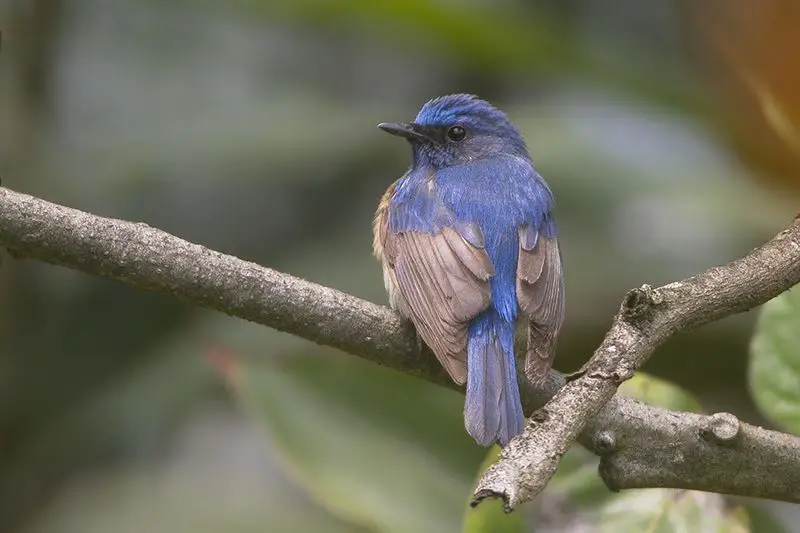
The Blue-throated blue flycatcher is a small passerine bird belonging to the Muscicapidae family. It has an unmistakable appearance, with its bright blue throat contrasting against its otherwise brown plumage.
This species can be found in much of the Indian Subcontinent, ranging from all through the Himalayas and plains to West Bengal.
Unlike other members of this genus, it prefers thicker forests as habitat rather than open areas or scrublands.
These birds mainly feed on insects which they catch by making short sallies into midair after taking off from perches at low levels among foliage and branches.
They are active during mornings and evenings when they become vocal while chirping away happily.Scientific classification:
| Kingdom | Animalia |
| Phylum | Chordata |
| Class | Aves |
| Order | Passeriformes |
| Family | Muscicapidae |
| Genus | Cyornis |
| Species | C. rubeculoides |
Also Featured In: Common Birds in Kerala,
44. Green-Tailed Sunbird
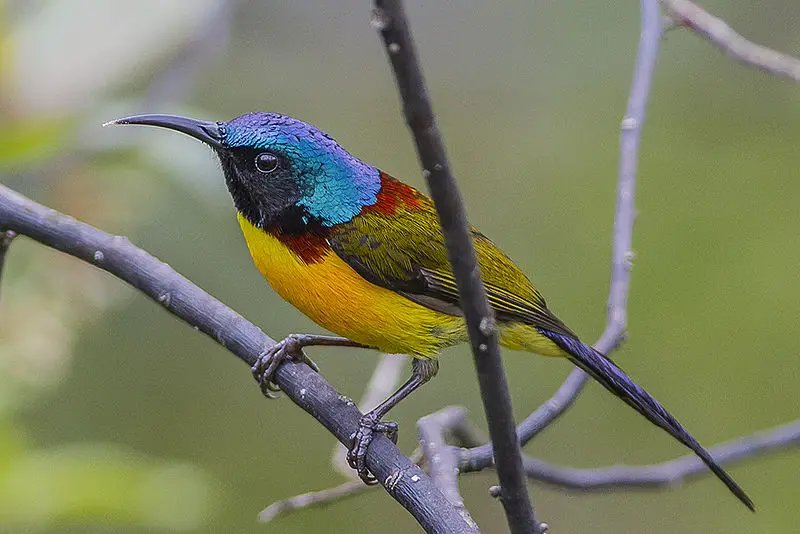
The Green-tailed Sunbird is a beautiful species of bird from the Nectariniidae family. It can be found in Nepal, northern regions of India and parts of Southeast Asia, living mainly in temperate forests and subtropical or tropical moist montane forests.
Generally it has an olive green body with yellow feathers on its back which gives it a unique look that sets it apart from other birds.
Its tail is also bright green which helps to identify them amongst others easily when perched upon trees or bushes searching for nectar and insects as part of their diet.
This sunbird typically lives alone but sometimes may form pairs during breeding season where they build intricate nests out of grasses woven together by spider webs.
All in all these vibrant little birds are truly remarkable creatures worthy our admiration.Scientific classification:
| Kingdom | Animalia |
| Phylum | Chordata |
| Class | Aves |
| Order | Passeriformes |
| Family | Nectariniidae |
| Genus | Aethopyga |
| Species | A. nipalensis |
45. Grey-Cheeked Warbler
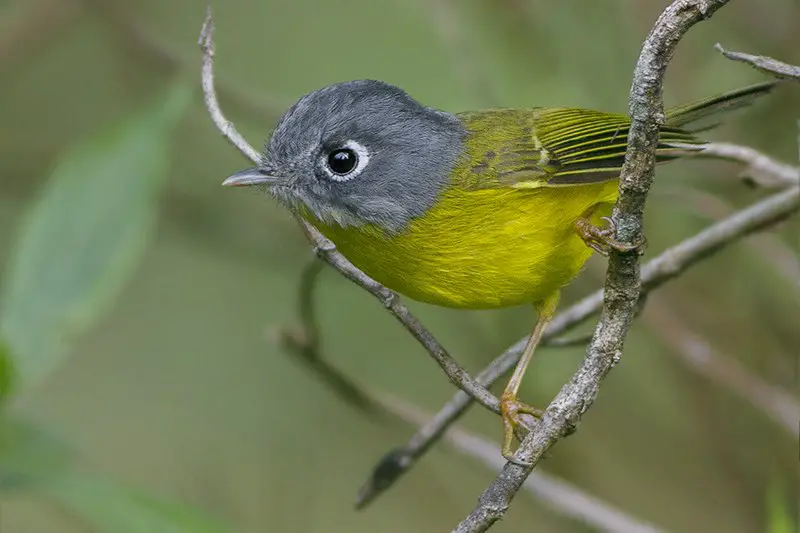
The Grey-cheeked Warbler is a species of leaf warbler found in Bangladesh, Bhutan, China, India, Laos, Myanmar, Nepal Thailand and Vietnam. It inhabits subtropical or tropical moist lowland forests as well as montane forests.
The population of this bird has decreased due to deforestation and habitat destruction caused by human activities like logging and burning for agricultural expansion.
Its diet consists mainly of insects which it captures while flitting among the branches of trees searching for food; its bright yellow head with brownish streaks on its wings make it easily recognizable amongst other birds.
Conservation efforts are needed to protect these habitats from further damage so that the populations can recover before they become endangered or extinct in some parts of their range.Scientific classification:
| Kingdom | Animalia |
| Phylum | Chordata |
| Class | Aves |
| Order | Passeriformes |
| Family | Phylloscopidae |
| Genus | Phylloscopus |
| Species | P. poliogenys |